Airline Operations Research Paper 2022
VerifiedAdded on 2022/09/26
|19
|3994
|41
AI Summary
Contribute Materials
Your contribution can guide someone’s learning journey. Share your
documents today.
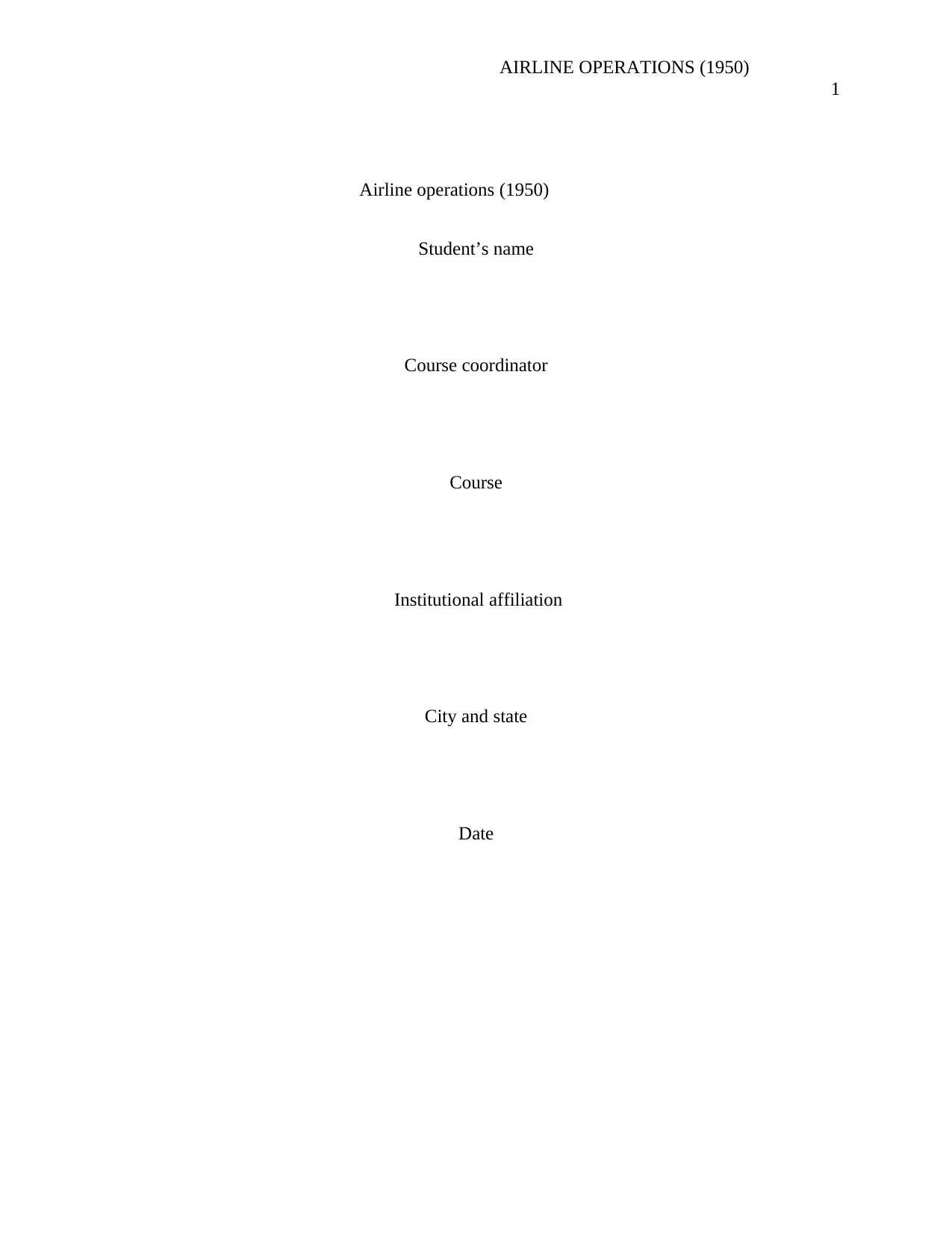
AIRLINE OPERATIONS (1950)
1
Airline operations (1950)
Student’s name
Course coordinator
Course
Institutional affiliation
City and state
Date
1
Airline operations (1950)
Student’s name
Course coordinator
Course
Institutional affiliation
City and state
Date
Secure Best Marks with AI Grader
Need help grading? Try our AI Grader for instant feedback on your assignments.
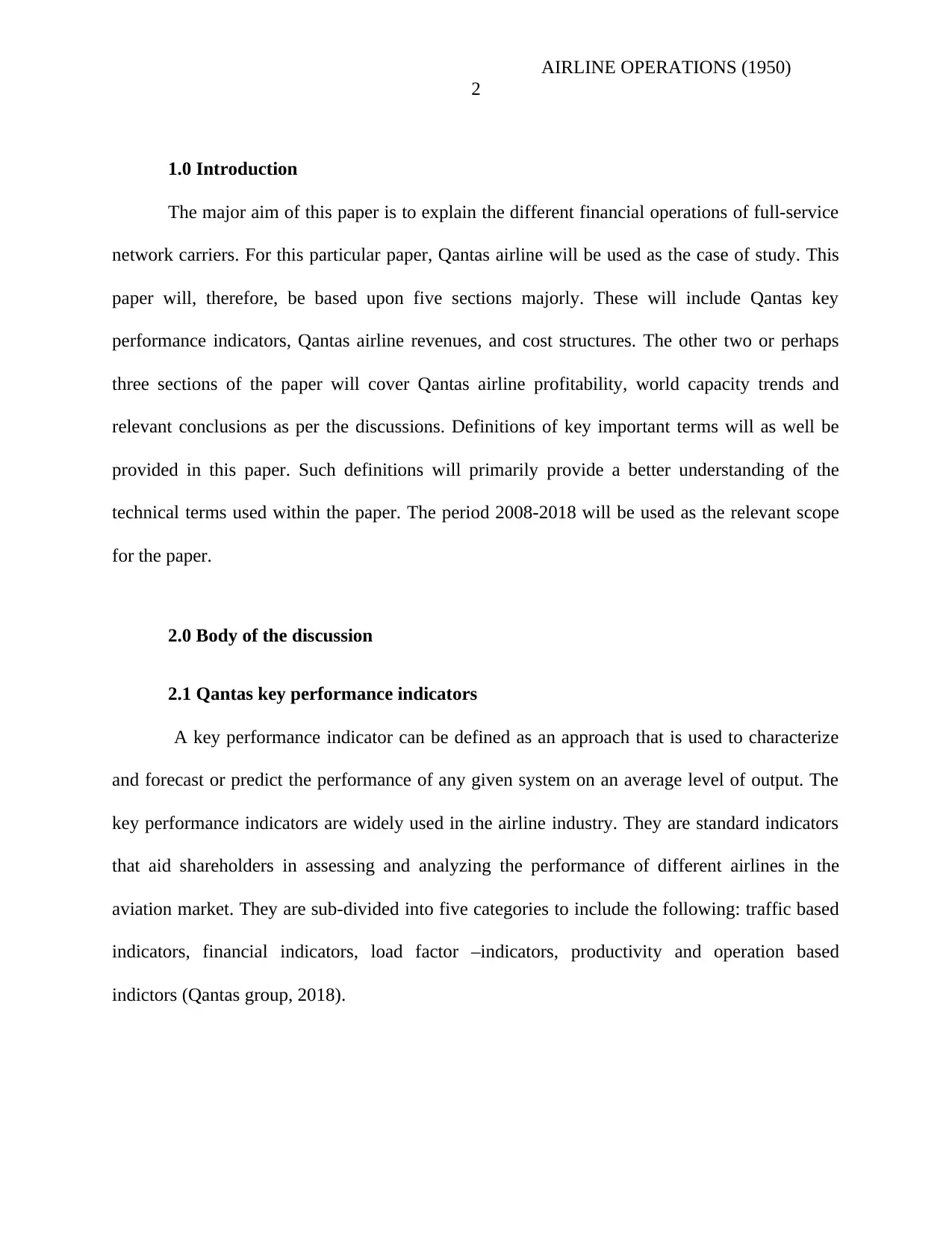
AIRLINE OPERATIONS (1950)
2
1.0 Introduction
The major aim of this paper is to explain the different financial operations of full-service
network carriers. For this particular paper, Qantas airline will be used as the case of study. This
paper will, therefore, be based upon five sections majorly. These will include Qantas key
performance indicators, Qantas airline revenues, and cost structures. The other two or perhaps
three sections of the paper will cover Qantas airline profitability, world capacity trends and
relevant conclusions as per the discussions. Definitions of key important terms will as well be
provided in this paper. Such definitions will primarily provide a better understanding of the
technical terms used within the paper. The period 2008-2018 will be used as the relevant scope
for the paper.
2.0 Body of the discussion
2.1 Qantas key performance indicators
A key performance indicator can be defined as an approach that is used to characterize
and forecast or predict the performance of any given system on an average level of output. The
key performance indicators are widely used in the airline industry. They are standard indicators
that aid shareholders in assessing and analyzing the performance of different airlines in the
aviation market. They are sub-divided into five categories to include the following: traffic based
indicators, financial indicators, load factor –indicators, productivity and operation based
indictors (Qantas group, 2018).
2
1.0 Introduction
The major aim of this paper is to explain the different financial operations of full-service
network carriers. For this particular paper, Qantas airline will be used as the case of study. This
paper will, therefore, be based upon five sections majorly. These will include Qantas key
performance indicators, Qantas airline revenues, and cost structures. The other two or perhaps
three sections of the paper will cover Qantas airline profitability, world capacity trends and
relevant conclusions as per the discussions. Definitions of key important terms will as well be
provided in this paper. Such definitions will primarily provide a better understanding of the
technical terms used within the paper. The period 2008-2018 will be used as the relevant scope
for the paper.
2.0 Body of the discussion
2.1 Qantas key performance indicators
A key performance indicator can be defined as an approach that is used to characterize
and forecast or predict the performance of any given system on an average level of output. The
key performance indicators are widely used in the airline industry. They are standard indicators
that aid shareholders in assessing and analyzing the performance of different airlines in the
aviation market. They are sub-divided into five categories to include the following: traffic based
indicators, financial indicators, load factor –indicators, productivity and operation based
indictors (Qantas group, 2018).
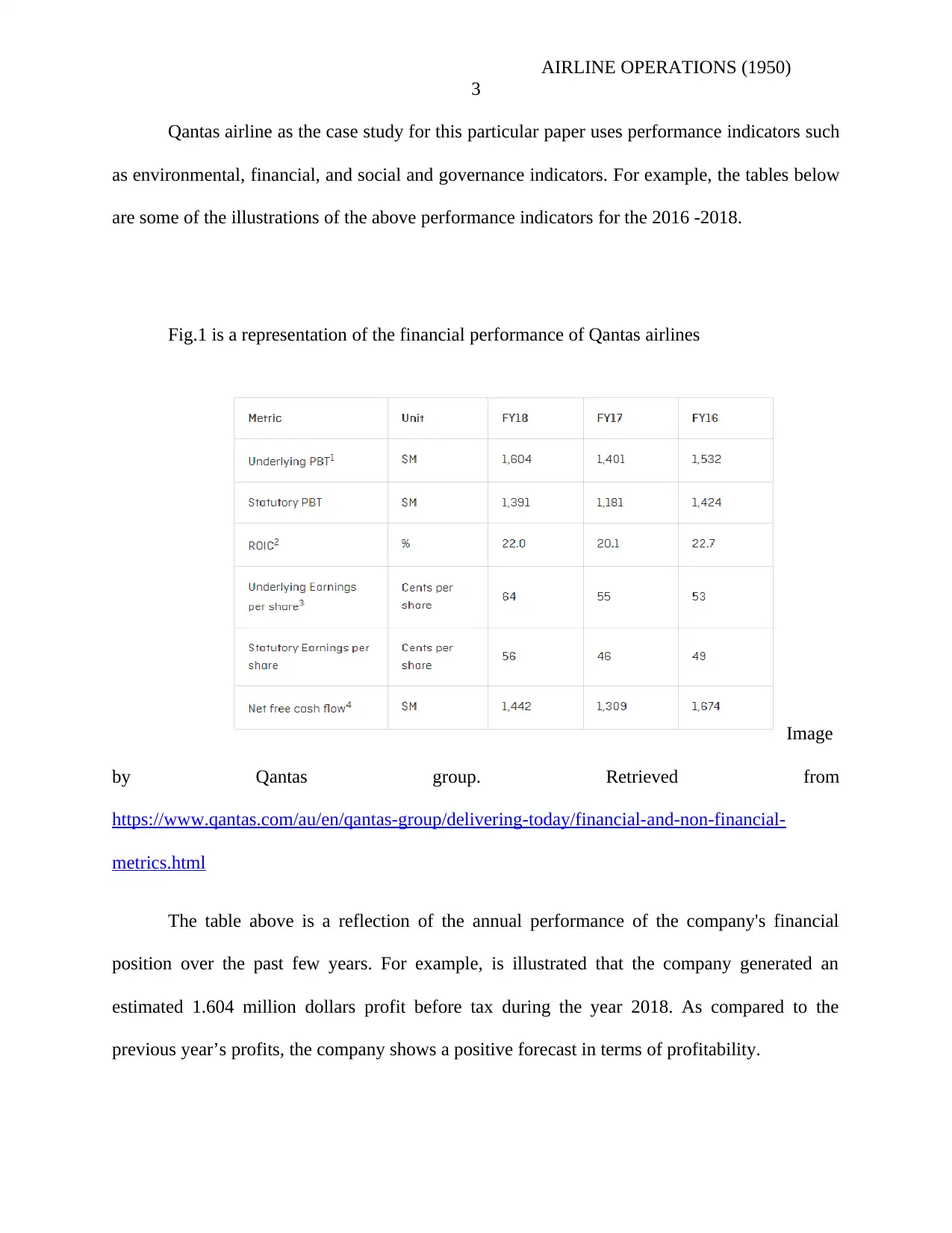
AIRLINE OPERATIONS (1950)
3
Qantas airline as the case study for this particular paper uses performance indicators such
as environmental, financial, and social and governance indicators. For example, the tables below
are some of the illustrations of the above performance indicators for the 2016 -2018.
Fig.1 is a representation of the financial performance of Qantas airlines
Image
by Qantas group. Retrieved from
https://www.qantas.com/au/en/qantas-group/delivering-today/financial-and-non-financial-
metrics.html
The table above is a reflection of the annual performance of the company's financial
position over the past few years. For example, is illustrated that the company generated an
estimated 1.604 million dollars profit before tax during the year 2018. As compared to the
previous year’s profits, the company shows a positive forecast in terms of profitability.
3
Qantas airline as the case study for this particular paper uses performance indicators such
as environmental, financial, and social and governance indicators. For example, the tables below
are some of the illustrations of the above performance indicators for the 2016 -2018.
Fig.1 is a representation of the financial performance of Qantas airlines
Image
by Qantas group. Retrieved from
https://www.qantas.com/au/en/qantas-group/delivering-today/financial-and-non-financial-
metrics.html
The table above is a reflection of the annual performance of the company's financial
position over the past few years. For example, is illustrated that the company generated an
estimated 1.604 million dollars profit before tax during the year 2018. As compared to the
previous year’s profits, the company shows a positive forecast in terms of profitability.
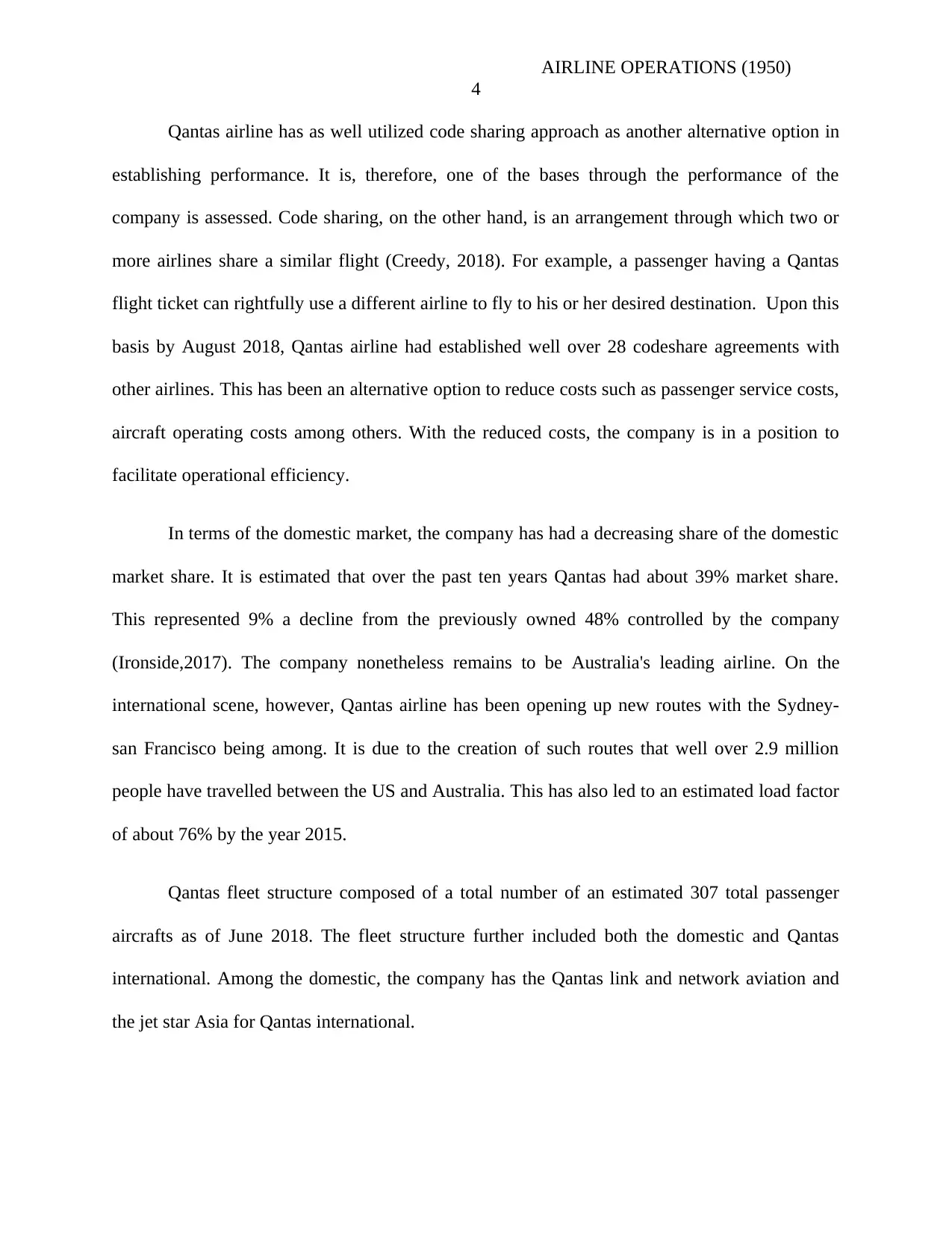
AIRLINE OPERATIONS (1950)
4
Qantas airline has as well utilized code sharing approach as another alternative option in
establishing performance. It is, therefore, one of the bases through the performance of the
company is assessed. Code sharing, on the other hand, is an arrangement through which two or
more airlines share a similar flight (Creedy, 2018). For example, a passenger having a Qantas
flight ticket can rightfully use a different airline to fly to his or her desired destination. Upon this
basis by August 2018, Qantas airline had established well over 28 codeshare agreements with
other airlines. This has been an alternative option to reduce costs such as passenger service costs,
aircraft operating costs among others. With the reduced costs, the company is in a position to
facilitate operational efficiency.
In terms of the domestic market, the company has had a decreasing share of the domestic
market share. It is estimated that over the past ten years Qantas had about 39% market share.
This represented 9% a decline from the previously owned 48% controlled by the company
(Ironside,2017). The company nonetheless remains to be Australia's leading airline. On the
international scene, however, Qantas airline has been opening up new routes with the Sydney-
san Francisco being among. It is due to the creation of such routes that well over 2.9 million
people have travelled between the US and Australia. This has also led to an estimated load factor
of about 76% by the year 2015.
Qantas fleet structure composed of a total number of an estimated 307 total passenger
aircrafts as of June 2018. The fleet structure further included both the domestic and Qantas
international. Among the domestic, the company has the Qantas link and network aviation and
the jet star Asia for Qantas international.
4
Qantas airline has as well utilized code sharing approach as another alternative option in
establishing performance. It is, therefore, one of the bases through the performance of the
company is assessed. Code sharing, on the other hand, is an arrangement through which two or
more airlines share a similar flight (Creedy, 2018). For example, a passenger having a Qantas
flight ticket can rightfully use a different airline to fly to his or her desired destination. Upon this
basis by August 2018, Qantas airline had established well over 28 codeshare agreements with
other airlines. This has been an alternative option to reduce costs such as passenger service costs,
aircraft operating costs among others. With the reduced costs, the company is in a position to
facilitate operational efficiency.
In terms of the domestic market, the company has had a decreasing share of the domestic
market share. It is estimated that over the past ten years Qantas had about 39% market share.
This represented 9% a decline from the previously owned 48% controlled by the company
(Ironside,2017). The company nonetheless remains to be Australia's leading airline. On the
international scene, however, Qantas airline has been opening up new routes with the Sydney-
san Francisco being among. It is due to the creation of such routes that well over 2.9 million
people have travelled between the US and Australia. This has also led to an estimated load factor
of about 76% by the year 2015.
Qantas fleet structure composed of a total number of an estimated 307 total passenger
aircrafts as of June 2018. The fleet structure further included both the domestic and Qantas
international. Among the domestic, the company has the Qantas link and network aviation and
the jet star Asia for Qantas international.
Secure Best Marks with AI Grader
Need help grading? Try our AI Grader for instant feedback on your assignments.
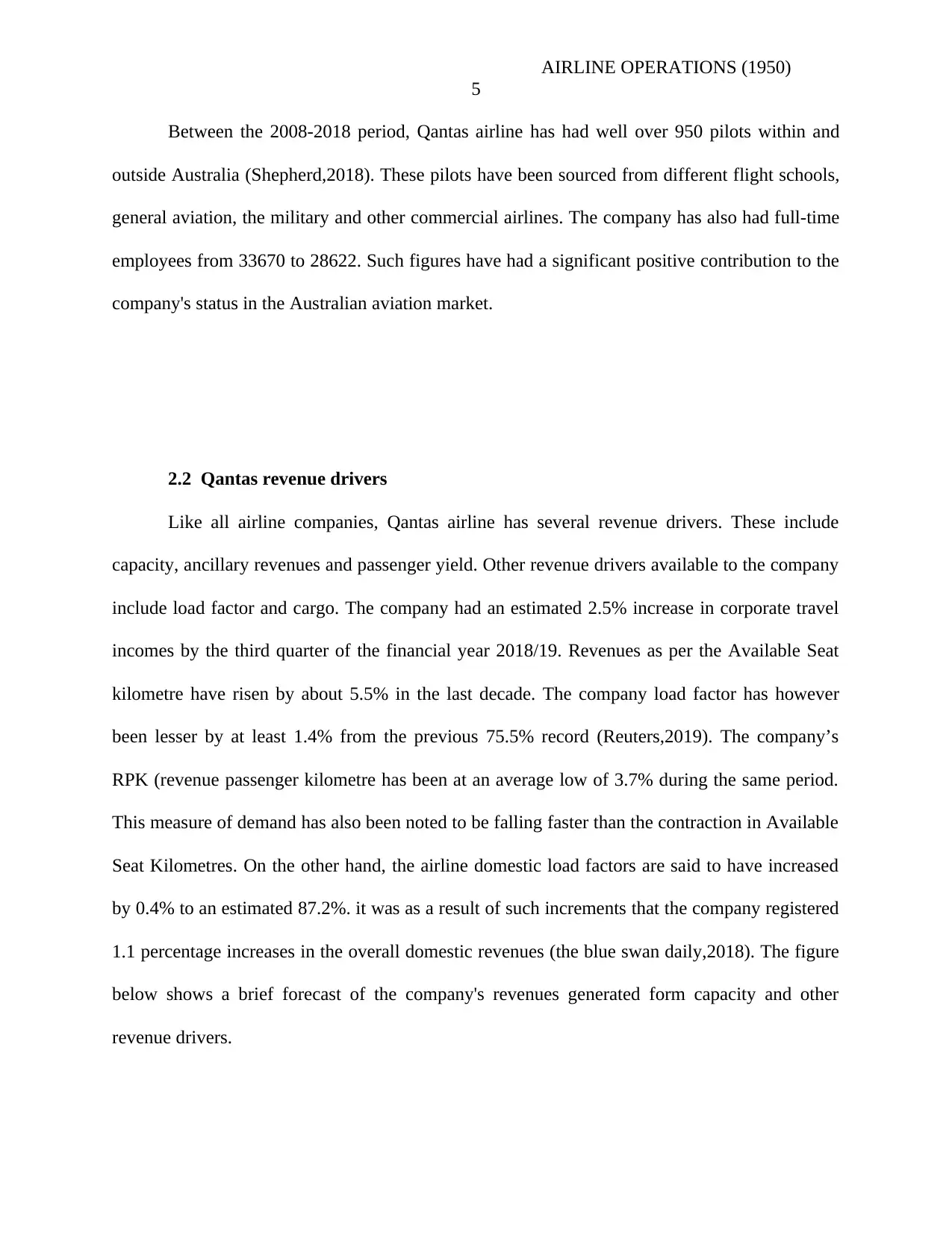
AIRLINE OPERATIONS (1950)
5
Between the 2008-2018 period, Qantas airline has had well over 950 pilots within and
outside Australia (Shepherd,2018). These pilots have been sourced from different flight schools,
general aviation, the military and other commercial airlines. The company has also had full-time
employees from 33670 to 28622. Such figures have had a significant positive contribution to the
company's status in the Australian aviation market.
2.2 Qantas revenue drivers
Like all airline companies, Qantas airline has several revenue drivers. These include
capacity, ancillary revenues and passenger yield. Other revenue drivers available to the company
include load factor and cargo. The company had an estimated 2.5% increase in corporate travel
incomes by the third quarter of the financial year 2018/19. Revenues as per the Available Seat
kilometre have risen by about 5.5% in the last decade. The company load factor has however
been lesser by at least 1.4% from the previous 75.5% record (Reuters,2019). The company’s
RPK (revenue passenger kilometre has been at an average low of 3.7% during the same period.
This measure of demand has also been noted to be falling faster than the contraction in Available
Seat Kilometres. On the other hand, the airline domestic load factors are said to have increased
by 0.4% to an estimated 87.2%. it was as a result of such increments that the company registered
1.1 percentage increases in the overall domestic revenues (the blue swan daily,2018). The figure
below shows a brief forecast of the company's revenues generated form capacity and other
revenue drivers.
5
Between the 2008-2018 period, Qantas airline has had well over 950 pilots within and
outside Australia (Shepherd,2018). These pilots have been sourced from different flight schools,
general aviation, the military and other commercial airlines. The company has also had full-time
employees from 33670 to 28622. Such figures have had a significant positive contribution to the
company's status in the Australian aviation market.
2.2 Qantas revenue drivers
Like all airline companies, Qantas airline has several revenue drivers. These include
capacity, ancillary revenues and passenger yield. Other revenue drivers available to the company
include load factor and cargo. The company had an estimated 2.5% increase in corporate travel
incomes by the third quarter of the financial year 2018/19. Revenues as per the Available Seat
kilometre have risen by about 5.5% in the last decade. The company load factor has however
been lesser by at least 1.4% from the previous 75.5% record (Reuters,2019). The company’s
RPK (revenue passenger kilometre has been at an average low of 3.7% during the same period.
This measure of demand has also been noted to be falling faster than the contraction in Available
Seat Kilometres. On the other hand, the airline domestic load factors are said to have increased
by 0.4% to an estimated 87.2%. it was as a result of such increments that the company registered
1.1 percentage increases in the overall domestic revenues (the blue swan daily,2018). The figure
below shows a brief forecast of the company's revenues generated form capacity and other
revenue drivers.
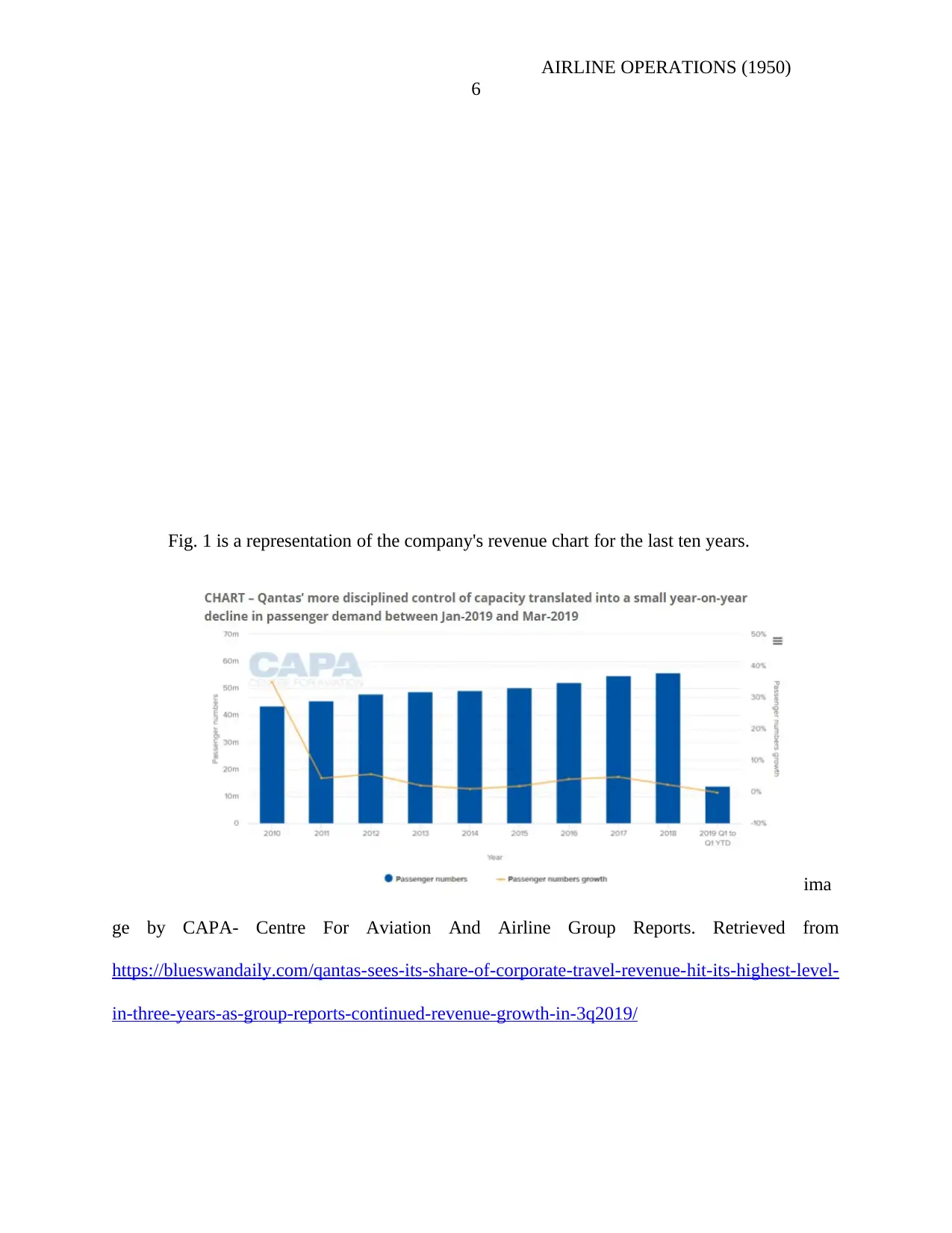
AIRLINE OPERATIONS (1950)
6
Fig. 1 is a representation of the company's revenue chart for the last ten years.
ima
ge by CAPA- Centre For Aviation And Airline Group Reports. Retrieved from
https://blueswandaily.com/qantas-sees-its-share-of-corporate-travel-revenue-hit-its-highest-level-
in-three-years-as-group-reports-continued-revenue-growth-in-3q2019/
6
Fig. 1 is a representation of the company's revenue chart for the last ten years.
ima
ge by CAPA- Centre For Aviation And Airline Group Reports. Retrieved from
https://blueswandaily.com/qantas-sees-its-share-of-corporate-travel-revenue-hit-its-highest-level-
in-three-years-as-group-reports-continued-revenue-growth-in-3q2019/
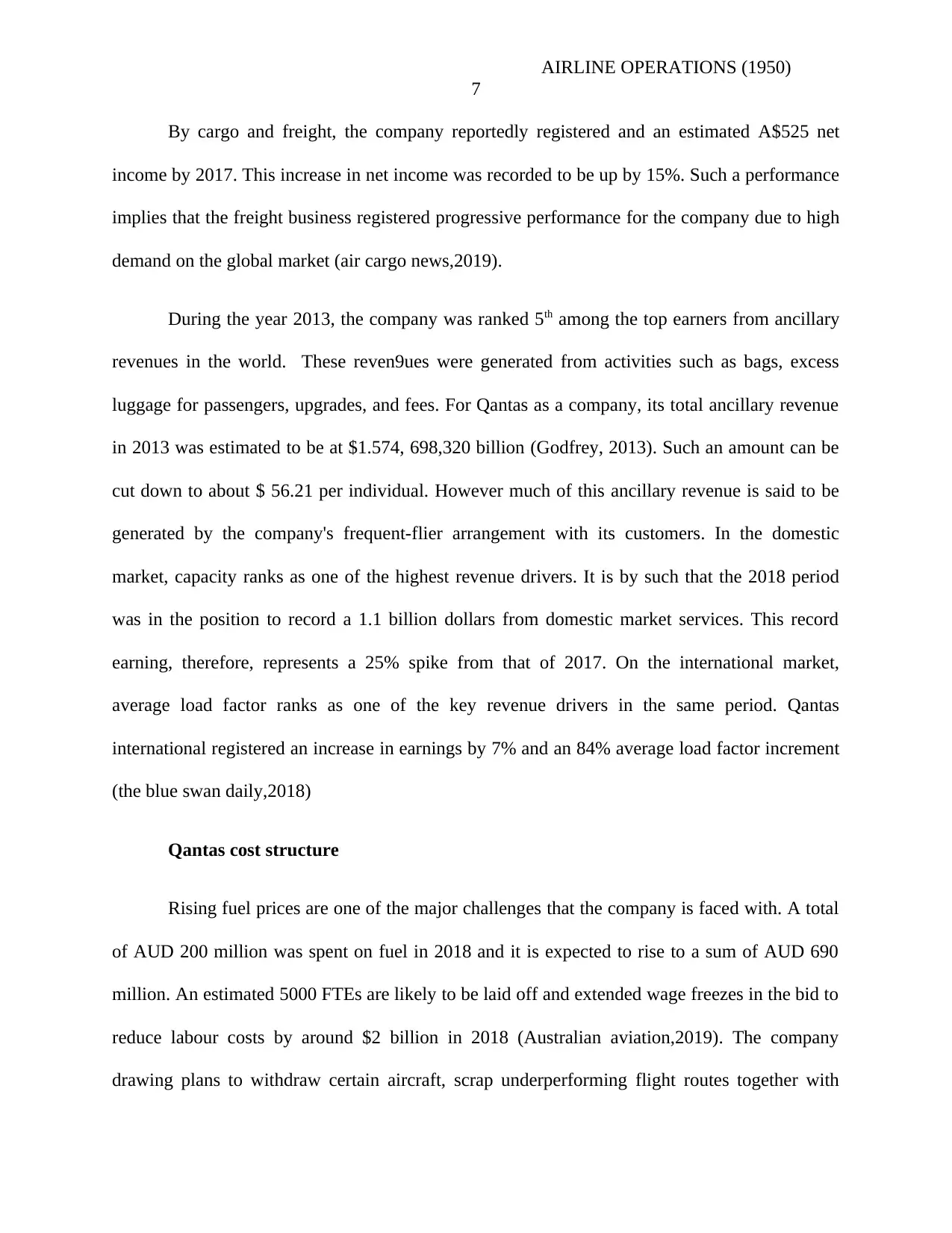
AIRLINE OPERATIONS (1950)
7
By cargo and freight, the company reportedly registered and an estimated A$525 net
income by 2017. This increase in net income was recorded to be up by 15%. Such a performance
implies that the freight business registered progressive performance for the company due to high
demand on the global market (air cargo news,2019).
During the year 2013, the company was ranked 5th among the top earners from ancillary
revenues in the world. These reven9ues were generated from activities such as bags, excess
luggage for passengers, upgrades, and fees. For Qantas as a company, its total ancillary revenue
in 2013 was estimated to be at $1.574, 698,320 billion (Godfrey, 2013). Such an amount can be
cut down to about $ 56.21 per individual. However much of this ancillary revenue is said to be
generated by the company's frequent-flier arrangement with its customers. In the domestic
market, capacity ranks as one of the highest revenue drivers. It is by such that the 2018 period
was in the position to record a 1.1 billion dollars from domestic market services. This record
earning, therefore, represents a 25% spike from that of 2017. On the international market,
average load factor ranks as one of the key revenue drivers in the same period. Qantas
international registered an increase in earnings by 7% and an 84% average load factor increment
(the blue swan daily,2018)
Qantas cost structure
Rising fuel prices are one of the major challenges that the company is faced with. A total
of AUD 200 million was spent on fuel in 2018 and it is expected to rise to a sum of AUD 690
million. An estimated 5000 FTEs are likely to be laid off and extended wage freezes in the bid to
reduce labour costs by around $2 billion in 2018 (Australian aviation,2019). The company
drawing plans to withdraw certain aircraft, scrap underperforming flight routes together with
7
By cargo and freight, the company reportedly registered and an estimated A$525 net
income by 2017. This increase in net income was recorded to be up by 15%. Such a performance
implies that the freight business registered progressive performance for the company due to high
demand on the global market (air cargo news,2019).
During the year 2013, the company was ranked 5th among the top earners from ancillary
revenues in the world. These reven9ues were generated from activities such as bags, excess
luggage for passengers, upgrades, and fees. For Qantas as a company, its total ancillary revenue
in 2013 was estimated to be at $1.574, 698,320 billion (Godfrey, 2013). Such an amount can be
cut down to about $ 56.21 per individual. However much of this ancillary revenue is said to be
generated by the company's frequent-flier arrangement with its customers. In the domestic
market, capacity ranks as one of the highest revenue drivers. It is by such that the 2018 period
was in the position to record a 1.1 billion dollars from domestic market services. This record
earning, therefore, represents a 25% spike from that of 2017. On the international market,
average load factor ranks as one of the key revenue drivers in the same period. Qantas
international registered an increase in earnings by 7% and an 84% average load factor increment
(the blue swan daily,2018)
Qantas cost structure
Rising fuel prices are one of the major challenges that the company is faced with. A total
of AUD 200 million was spent on fuel in 2018 and it is expected to rise to a sum of AUD 690
million. An estimated 5000 FTEs are likely to be laid off and extended wage freezes in the bid to
reduce labour costs by around $2 billion in 2018 (Australian aviation,2019). The company
drawing plans to withdraw certain aircraft, scrap underperforming flight routes together with
Paraphrase This Document
Need a fresh take? Get an instant paraphrase of this document with our AI Paraphraser
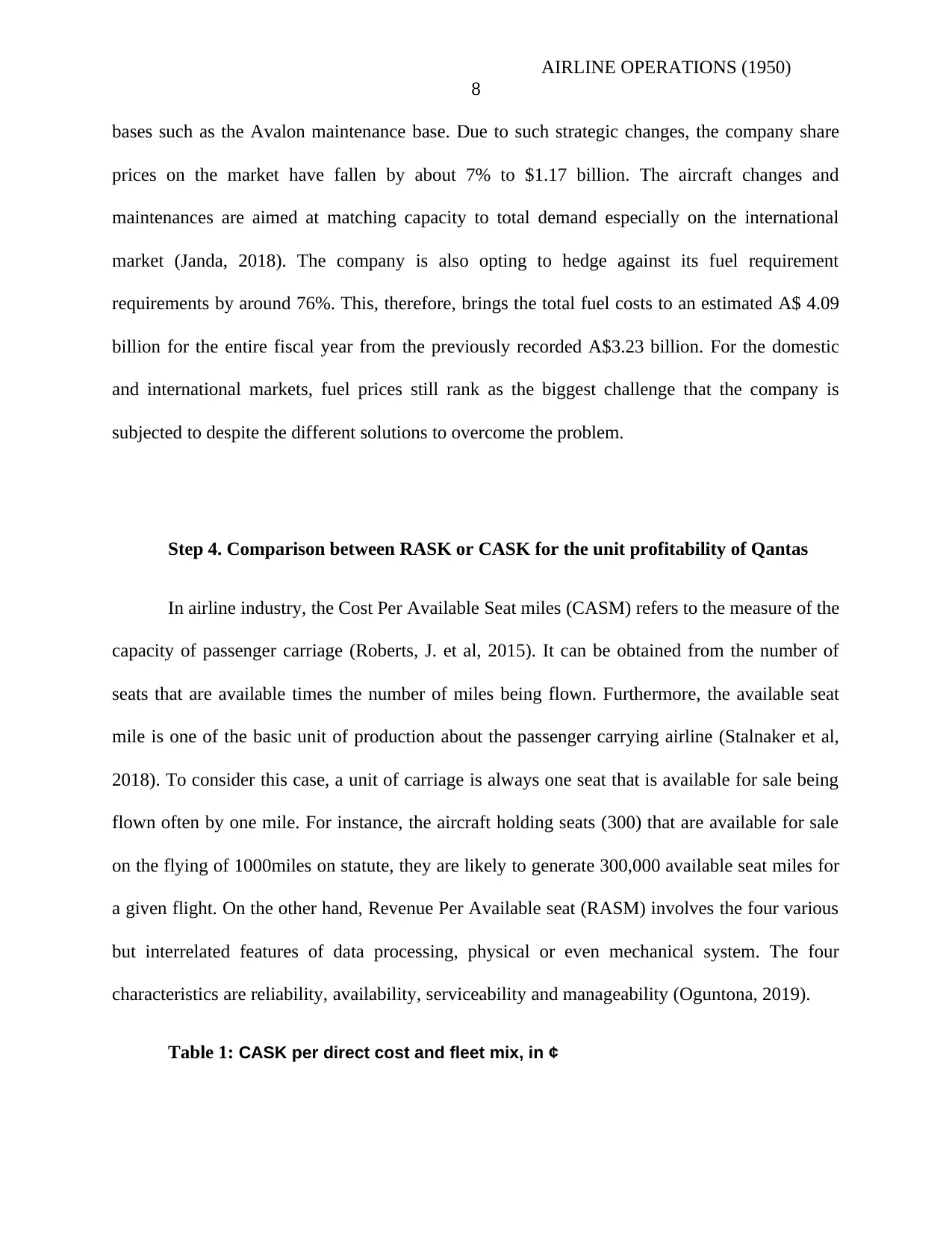
AIRLINE OPERATIONS (1950)
8
bases such as the Avalon maintenance base. Due to such strategic changes, the company share
prices on the market have fallen by about 7% to $1.17 billion. The aircraft changes and
maintenances are aimed at matching capacity to total demand especially on the international
market (Janda, 2018). The company is also opting to hedge against its fuel requirement
requirements by around 76%. This, therefore, brings the total fuel costs to an estimated A$ 4.09
billion for the entire fiscal year from the previously recorded A$3.23 billion. For the domestic
and international markets, fuel prices still rank as the biggest challenge that the company is
subjected to despite the different solutions to overcome the problem.
Step 4. Comparison between RASK or CASK for the unit profitability of Qantas
In airline industry, the Cost Per Available Seat miles (CASM) refers to the measure of the
capacity of passenger carriage (Roberts, J. et al, 2015). It can be obtained from the number of
seats that are available times the number of miles being flown. Furthermore, the available seat
mile is one of the basic unit of production about the passenger carrying airline (Stalnaker et al,
2018). To consider this case, a unit of carriage is always one seat that is available for sale being
flown often by one mile. For instance, the aircraft holding seats (300) that are available for sale
on the flying of 1000miles on statute, they are likely to generate 300,000 available seat miles for
a given flight. On the other hand, Revenue Per Available seat (RASM) involves the four various
but interrelated features of data processing, physical or even mechanical system. The four
characteristics are reliability, availability, serviceability and manageability (Oguntona, 2019).
Table 1: CASK per direct cost and fleet mix, in ¢
8
bases such as the Avalon maintenance base. Due to such strategic changes, the company share
prices on the market have fallen by about 7% to $1.17 billion. The aircraft changes and
maintenances are aimed at matching capacity to total demand especially on the international
market (Janda, 2018). The company is also opting to hedge against its fuel requirement
requirements by around 76%. This, therefore, brings the total fuel costs to an estimated A$ 4.09
billion for the entire fiscal year from the previously recorded A$3.23 billion. For the domestic
and international markets, fuel prices still rank as the biggest challenge that the company is
subjected to despite the different solutions to overcome the problem.
Step 4. Comparison between RASK or CASK for the unit profitability of Qantas
In airline industry, the Cost Per Available Seat miles (CASM) refers to the measure of the
capacity of passenger carriage (Roberts, J. et al, 2015). It can be obtained from the number of
seats that are available times the number of miles being flown. Furthermore, the available seat
mile is one of the basic unit of production about the passenger carrying airline (Stalnaker et al,
2018). To consider this case, a unit of carriage is always one seat that is available for sale being
flown often by one mile. For instance, the aircraft holding seats (300) that are available for sale
on the flying of 1000miles on statute, they are likely to generate 300,000 available seat miles for
a given flight. On the other hand, Revenue Per Available seat (RASM) involves the four various
but interrelated features of data processing, physical or even mechanical system. The four
characteristics are reliability, availability, serviceability and manageability (Oguntona, 2019).
Table 1: CASK per direct cost and fleet mix, in ¢
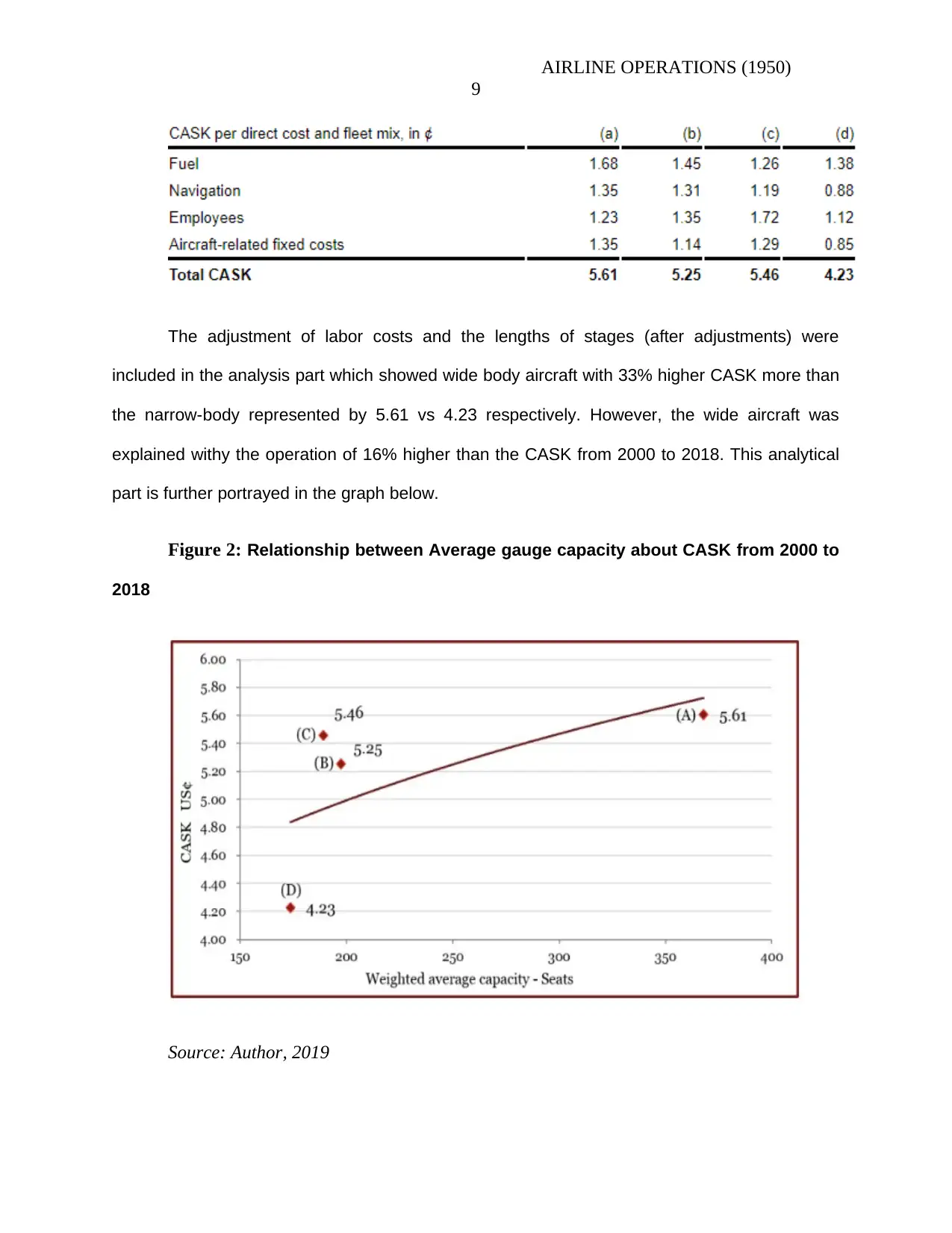
AIRLINE OPERATIONS (1950)
9
The adjustment of labor costs and the lengths of stages (after adjustments) were
included in the analysis part which showed wide body aircraft with 33% higher CASK more than
the narrow-body represented by 5.61 vs 4.23 respectively. However, the wide aircraft was
explained withy the operation of 16% higher than the CASK from 2000 to 2018. This analytical
part is further portrayed in the graph below.
Figure 2: Relationship between Average gauge capacity about CASK from 2000 to
2018
Source: Author, 2019
9
The adjustment of labor costs and the lengths of stages (after adjustments) were
included in the analysis part which showed wide body aircraft with 33% higher CASK more than
the narrow-body represented by 5.61 vs 4.23 respectively. However, the wide aircraft was
explained withy the operation of 16% higher than the CASK from 2000 to 2018. This analytical
part is further portrayed in the graph below.
Figure 2: Relationship between Average gauge capacity about CASK from 2000 to
2018
Source: Author, 2019
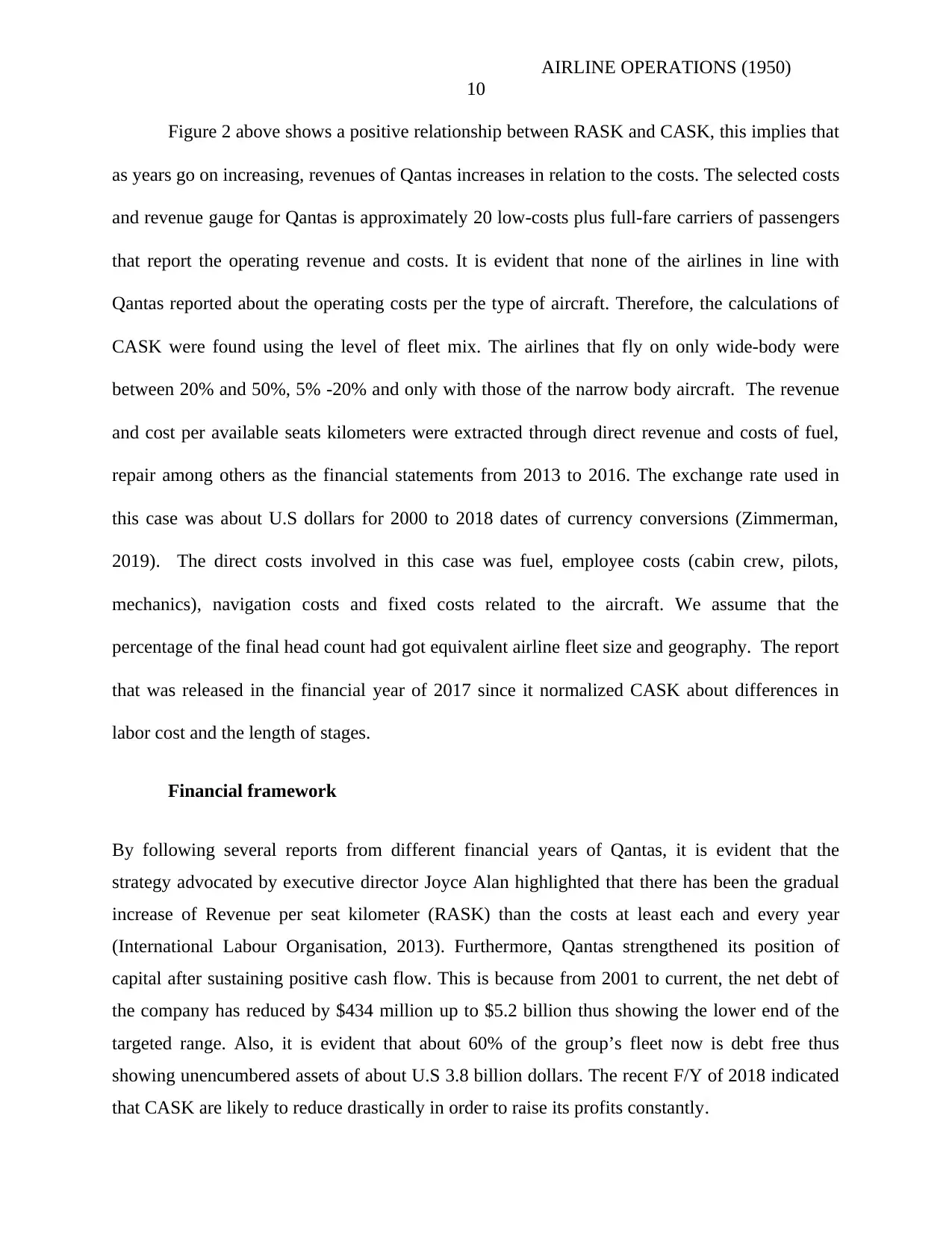
AIRLINE OPERATIONS (1950)
10
Figure 2 above shows a positive relationship between RASK and CASK, this implies that
as years go on increasing, revenues of Qantas increases in relation to the costs. The selected costs
and revenue gauge for Qantas is approximately 20 low-costs plus full-fare carriers of passengers
that report the operating revenue and costs. It is evident that none of the airlines in line with
Qantas reported about the operating costs per the type of aircraft. Therefore, the calculations of
CASK were found using the level of fleet mix. The airlines that fly on only wide-body were
between 20% and 50%, 5% -20% and only with those of the narrow body aircraft. The revenue
and cost per available seats kilometers were extracted through direct revenue and costs of fuel,
repair among others as the financial statements from 2013 to 2016. The exchange rate used in
this case was about U.S dollars for 2000 to 2018 dates of currency conversions (Zimmerman,
2019). The direct costs involved in this case was fuel, employee costs (cabin crew, pilots,
mechanics), navigation costs and fixed costs related to the aircraft. We assume that the
percentage of the final head count had got equivalent airline fleet size and geography. The report
that was released in the financial year of 2017 since it normalized CASK about differences in
labor cost and the length of stages.
Financial framework
By following several reports from different financial years of Qantas, it is evident that the
strategy advocated by executive director Joyce Alan highlighted that there has been the gradual
increase of Revenue per seat kilometer (RASK) than the costs at least each and every year
(International Labour Organisation, 2013). Furthermore, Qantas strengthened its position of
capital after sustaining positive cash flow. This is because from 2001 to current, the net debt of
the company has reduced by $434 million up to $5.2 billion thus showing the lower end of the
targeted range. Also, it is evident that about 60% of the group’s fleet now is debt free thus
showing unencumbered assets of about U.S 3.8 billion dollars. The recent F/Y of 2018 indicated
that CASK are likely to reduce drastically in order to raise its profits constantly.
10
Figure 2 above shows a positive relationship between RASK and CASK, this implies that
as years go on increasing, revenues of Qantas increases in relation to the costs. The selected costs
and revenue gauge for Qantas is approximately 20 low-costs plus full-fare carriers of passengers
that report the operating revenue and costs. It is evident that none of the airlines in line with
Qantas reported about the operating costs per the type of aircraft. Therefore, the calculations of
CASK were found using the level of fleet mix. The airlines that fly on only wide-body were
between 20% and 50%, 5% -20% and only with those of the narrow body aircraft. The revenue
and cost per available seats kilometers were extracted through direct revenue and costs of fuel,
repair among others as the financial statements from 2013 to 2016. The exchange rate used in
this case was about U.S dollars for 2000 to 2018 dates of currency conversions (Zimmerman,
2019). The direct costs involved in this case was fuel, employee costs (cabin crew, pilots,
mechanics), navigation costs and fixed costs related to the aircraft. We assume that the
percentage of the final head count had got equivalent airline fleet size and geography. The report
that was released in the financial year of 2017 since it normalized CASK about differences in
labor cost and the length of stages.
Financial framework
By following several reports from different financial years of Qantas, it is evident that the
strategy advocated by executive director Joyce Alan highlighted that there has been the gradual
increase of Revenue per seat kilometer (RASK) than the costs at least each and every year
(International Labour Organisation, 2013). Furthermore, Qantas strengthened its position of
capital after sustaining positive cash flow. This is because from 2001 to current, the net debt of
the company has reduced by $434 million up to $5.2 billion thus showing the lower end of the
targeted range. Also, it is evident that about 60% of the group’s fleet now is debt free thus
showing unencumbered assets of about U.S 3.8 billion dollars. The recent F/Y of 2018 indicated
that CASK are likely to reduce drastically in order to raise its profits constantly.
Secure Best Marks with AI Grader
Need help grading? Try our AI Grader for instant feedback on your assignments.
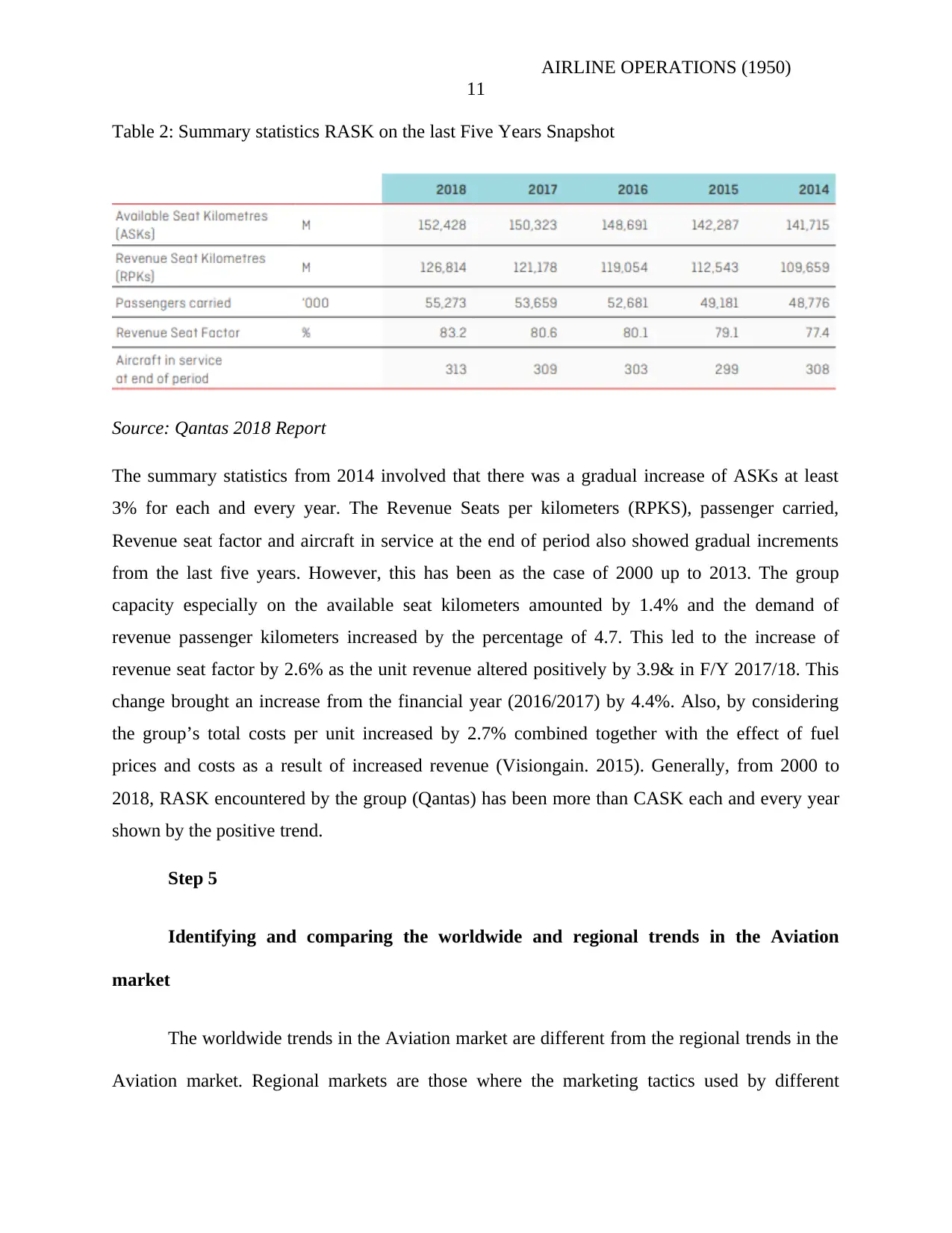
AIRLINE OPERATIONS (1950)
11
Table 2: Summary statistics RASK on the last Five Years Snapshot
Source: Qantas 2018 Report
The summary statistics from 2014 involved that there was a gradual increase of ASKs at least
3% for each and every year. The Revenue Seats per kilometers (RPKS), passenger carried,
Revenue seat factor and aircraft in service at the end of period also showed gradual increments
from the last five years. However, this has been as the case of 2000 up to 2013. The group
capacity especially on the available seat kilometers amounted by 1.4% and the demand of
revenue passenger kilometers increased by the percentage of 4.7. This led to the increase of
revenue seat factor by 2.6% as the unit revenue altered positively by 3.9& in F/Y 2017/18. This
change brought an increase from the financial year (2016/2017) by 4.4%. Also, by considering
the group’s total costs per unit increased by 2.7% combined together with the effect of fuel
prices and costs as a result of increased revenue (Visiongain. 2015). Generally, from 2000 to
2018, RASK encountered by the group (Qantas) has been more than CASK each and every year
shown by the positive trend.
Step 5
Identifying and comparing the worldwide and regional trends in the Aviation
market
The worldwide trends in the Aviation market are different from the regional trends in the
Aviation market. Regional markets are those where the marketing tactics used by different
11
Table 2: Summary statistics RASK on the last Five Years Snapshot
Source: Qantas 2018 Report
The summary statistics from 2014 involved that there was a gradual increase of ASKs at least
3% for each and every year. The Revenue Seats per kilometers (RPKS), passenger carried,
Revenue seat factor and aircraft in service at the end of period also showed gradual increments
from the last five years. However, this has been as the case of 2000 up to 2013. The group
capacity especially on the available seat kilometers amounted by 1.4% and the demand of
revenue passenger kilometers increased by the percentage of 4.7. This led to the increase of
revenue seat factor by 2.6% as the unit revenue altered positively by 3.9& in F/Y 2017/18. This
change brought an increase from the financial year (2016/2017) by 4.4%. Also, by considering
the group’s total costs per unit increased by 2.7% combined together with the effect of fuel
prices and costs as a result of increased revenue (Visiongain. 2015). Generally, from 2000 to
2018, RASK encountered by the group (Qantas) has been more than CASK each and every year
shown by the positive trend.
Step 5
Identifying and comparing the worldwide and regional trends in the Aviation
market
The worldwide trends in the Aviation market are different from the regional trends in the
Aviation market. Regional markets are those where the marketing tactics used by different
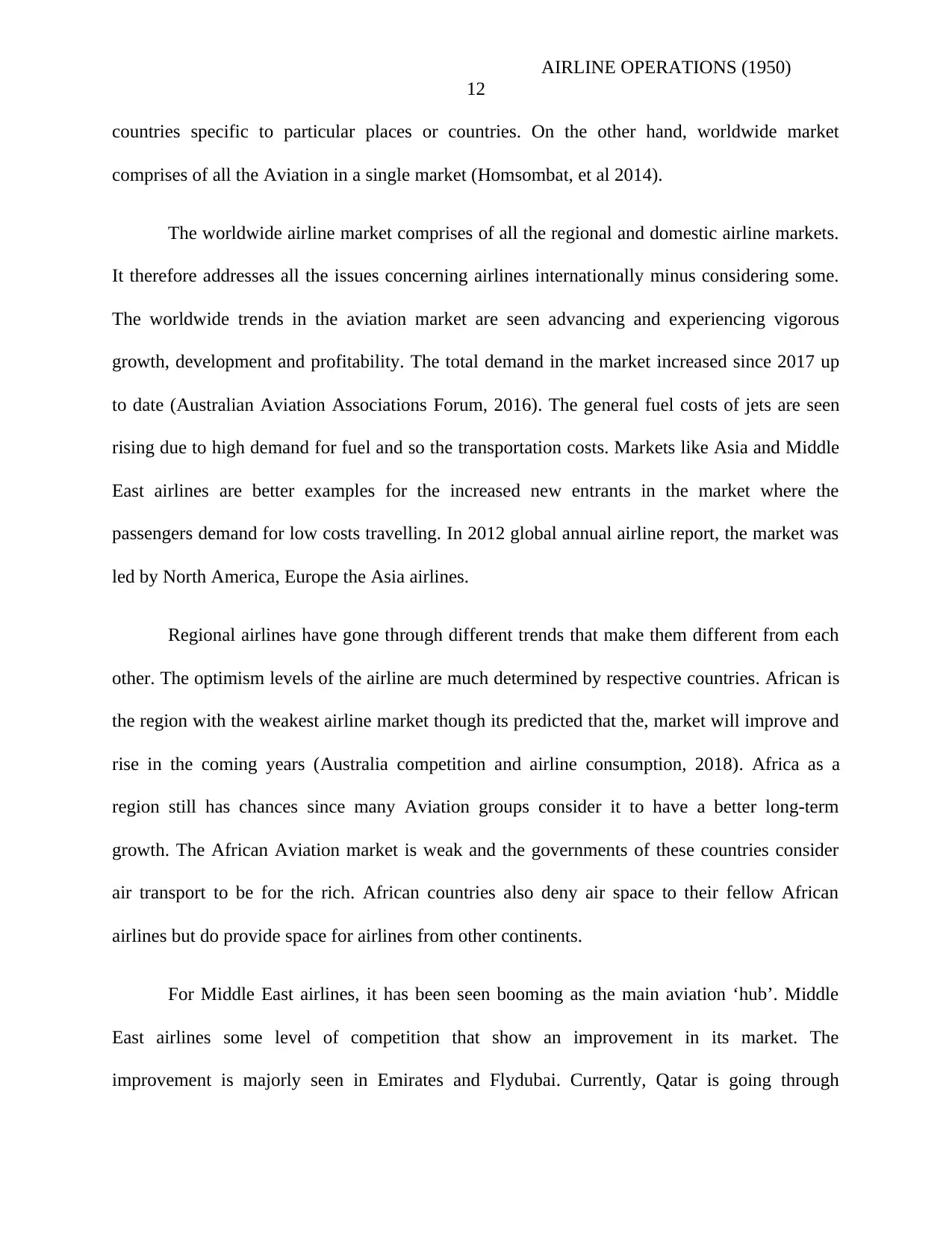
AIRLINE OPERATIONS (1950)
12
countries specific to particular places or countries. On the other hand, worldwide market
comprises of all the Aviation in a single market (Homsombat, et al 2014).
The worldwide airline market comprises of all the regional and domestic airline markets.
It therefore addresses all the issues concerning airlines internationally minus considering some.
The worldwide trends in the aviation market are seen advancing and experiencing vigorous
growth, development and profitability. The total demand in the market increased since 2017 up
to date (Australian Aviation Associations Forum, 2016). The general fuel costs of jets are seen
rising due to high demand for fuel and so the transportation costs. Markets like Asia and Middle
East airlines are better examples for the increased new entrants in the market where the
passengers demand for low costs travelling. In 2012 global annual airline report, the market was
led by North America, Europe the Asia airlines.
Regional airlines have gone through different trends that make them different from each
other. The optimism levels of the airline are much determined by respective countries. African is
the region with the weakest airline market though its predicted that the, market will improve and
rise in the coming years (Australia competition and airline consumption, 2018). Africa as a
region still has chances since many Aviation groups consider it to have a better long-term
growth. The African Aviation market is weak and the governments of these countries consider
air transport to be for the rich. African countries also deny air space to their fellow African
airlines but do provide space for airlines from other continents.
For Middle East airlines, it has been seen booming as the main aviation ‘hub’. Middle
East airlines some level of competition that show an improvement in its market. The
improvement is majorly seen in Emirates and Flydubai. Currently, Qatar is going through
12
countries specific to particular places or countries. On the other hand, worldwide market
comprises of all the Aviation in a single market (Homsombat, et al 2014).
The worldwide airline market comprises of all the regional and domestic airline markets.
It therefore addresses all the issues concerning airlines internationally minus considering some.
The worldwide trends in the aviation market are seen advancing and experiencing vigorous
growth, development and profitability. The total demand in the market increased since 2017 up
to date (Australian Aviation Associations Forum, 2016). The general fuel costs of jets are seen
rising due to high demand for fuel and so the transportation costs. Markets like Asia and Middle
East airlines are better examples for the increased new entrants in the market where the
passengers demand for low costs travelling. In 2012 global annual airline report, the market was
led by North America, Europe the Asia airlines.
Regional airlines have gone through different trends that make them different from each
other. The optimism levels of the airline are much determined by respective countries. African is
the region with the weakest airline market though its predicted that the, market will improve and
rise in the coming years (Australia competition and airline consumption, 2018). Africa as a
region still has chances since many Aviation groups consider it to have a better long-term
growth. The African Aviation market is weak and the governments of these countries consider
air transport to be for the rich. African countries also deny air space to their fellow African
airlines but do provide space for airlines from other continents.
For Middle East airlines, it has been seen booming as the main aviation ‘hub’. Middle
East airlines some level of competition that show an improvement in its market. The
improvement is majorly seen in Emirates and Flydubai. Currently, Qatar is going through
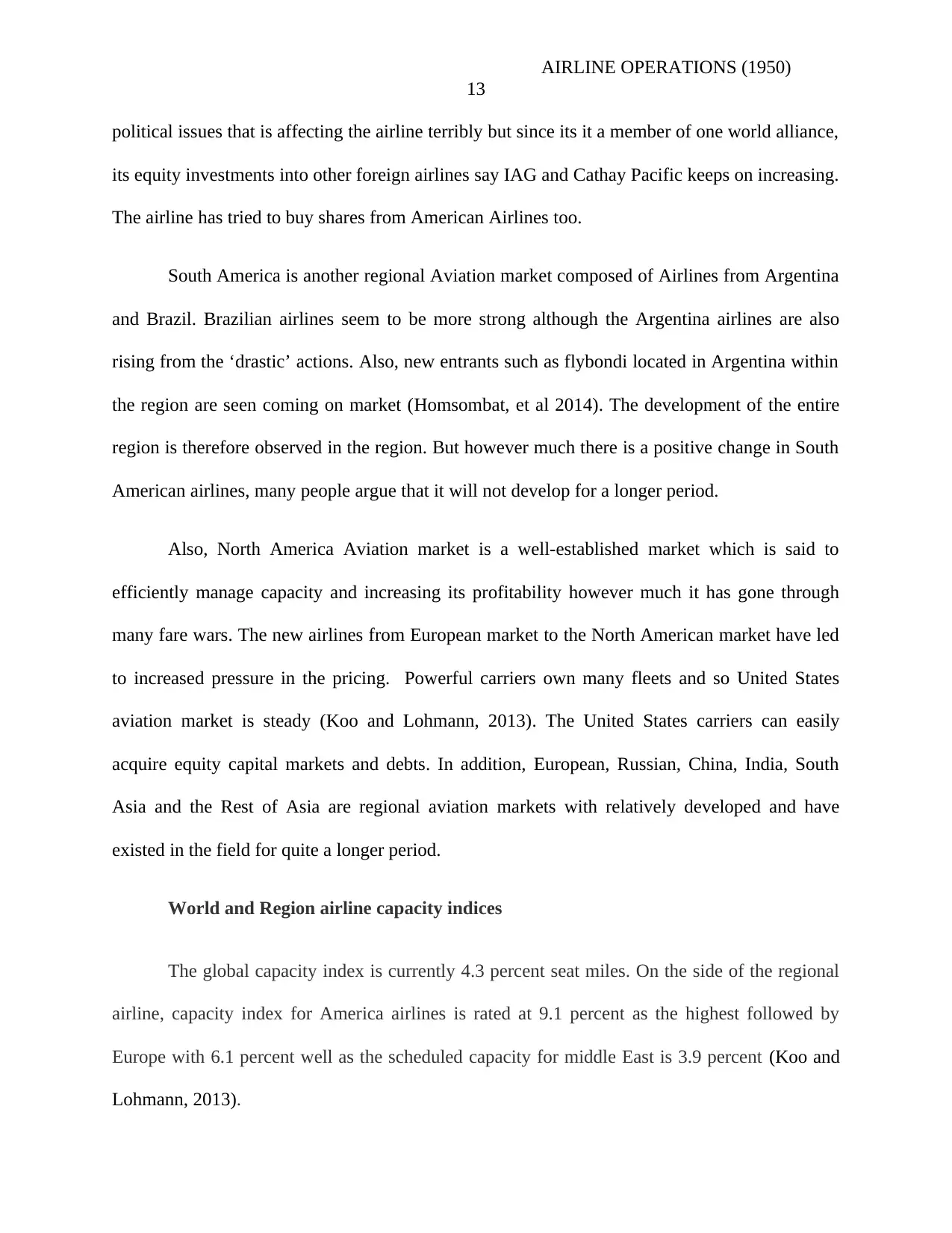
AIRLINE OPERATIONS (1950)
13
political issues that is affecting the airline terribly but since its it a member of one world alliance,
its equity investments into other foreign airlines say IAG and Cathay Pacific keeps on increasing.
The airline has tried to buy shares from American Airlines too.
South America is another regional Aviation market composed of Airlines from Argentina
and Brazil. Brazilian airlines seem to be more strong although the Argentina airlines are also
rising from the ‘drastic’ actions. Also, new entrants such as flybondi located in Argentina within
the region are seen coming on market (Homsombat, et al 2014). The development of the entire
region is therefore observed in the region. But however much there is a positive change in South
American airlines, many people argue that it will not develop for a longer period.
Also, North America Aviation market is a well-established market which is said to
efficiently manage capacity and increasing its profitability however much it has gone through
many fare wars. The new airlines from European market to the North American market have led
to increased pressure in the pricing. Powerful carriers own many fleets and so United States
aviation market is steady (Koo and Lohmann, 2013). The United States carriers can easily
acquire equity capital markets and debts. In addition, European, Russian, China, India, South
Asia and the Rest of Asia are regional aviation markets with relatively developed and have
existed in the field for quite a longer period.
World and Region airline capacity indices
The global capacity index is currently 4.3 percent seat miles. On the side of the regional
airline, capacity index for America airlines is rated at 9.1 percent as the highest followed by
Europe with 6.1 percent well as the scheduled capacity for middle East is 3.9 percent (Koo and
Lohmann, 2013).
13
political issues that is affecting the airline terribly but since its it a member of one world alliance,
its equity investments into other foreign airlines say IAG and Cathay Pacific keeps on increasing.
The airline has tried to buy shares from American Airlines too.
South America is another regional Aviation market composed of Airlines from Argentina
and Brazil. Brazilian airlines seem to be more strong although the Argentina airlines are also
rising from the ‘drastic’ actions. Also, new entrants such as flybondi located in Argentina within
the region are seen coming on market (Homsombat, et al 2014). The development of the entire
region is therefore observed in the region. But however much there is a positive change in South
American airlines, many people argue that it will not develop for a longer period.
Also, North America Aviation market is a well-established market which is said to
efficiently manage capacity and increasing its profitability however much it has gone through
many fare wars. The new airlines from European market to the North American market have led
to increased pressure in the pricing. Powerful carriers own many fleets and so United States
aviation market is steady (Koo and Lohmann, 2013). The United States carriers can easily
acquire equity capital markets and debts. In addition, European, Russian, China, India, South
Asia and the Rest of Asia are regional aviation markets with relatively developed and have
existed in the field for quite a longer period.
World and Region airline capacity indices
The global capacity index is currently 4.3 percent seat miles. On the side of the regional
airline, capacity index for America airlines is rated at 9.1 percent as the highest followed by
Europe with 6.1 percent well as the scheduled capacity for middle East is 3.9 percent (Koo and
Lohmann, 2013).
Paraphrase This Document
Need a fresh take? Get an instant paraphrase of this document with our AI Paraphraser
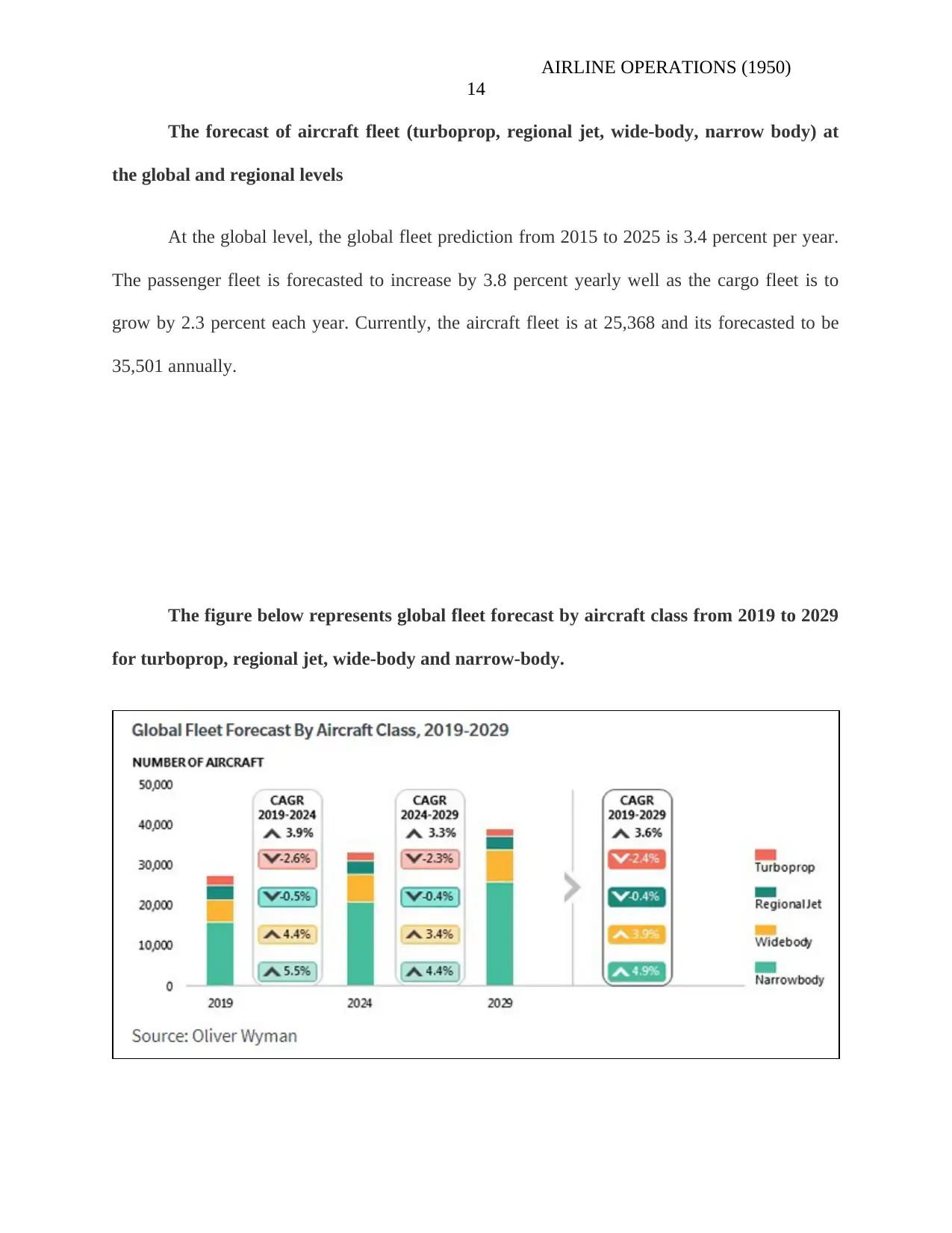
AIRLINE OPERATIONS (1950)
14
The forecast of aircraft fleet (turboprop, regional jet, wide-body, narrow body) at
the global and regional levels
At the global level, the global fleet prediction from 2015 to 2025 is 3.4 percent per year.
The passenger fleet is forecasted to increase by 3.8 percent yearly well as the cargo fleet is to
grow by 2.3 percent each year. Currently, the aircraft fleet is at 25,368 and its forecasted to be
35,501 annually.
The figure below represents global fleet forecast by aircraft class from 2019 to 2029
for turboprop, regional jet, wide-body and narrow-body.
14
The forecast of aircraft fleet (turboprop, regional jet, wide-body, narrow body) at
the global and regional levels
At the global level, the global fleet prediction from 2015 to 2025 is 3.4 percent per year.
The passenger fleet is forecasted to increase by 3.8 percent yearly well as the cargo fleet is to
grow by 2.3 percent each year. Currently, the aircraft fleet is at 25,368 and its forecasted to be
35,501 annually.
The figure below represents global fleet forecast by aircraft class from 2019 to 2029
for turboprop, regional jet, wide-body and narrow-body.
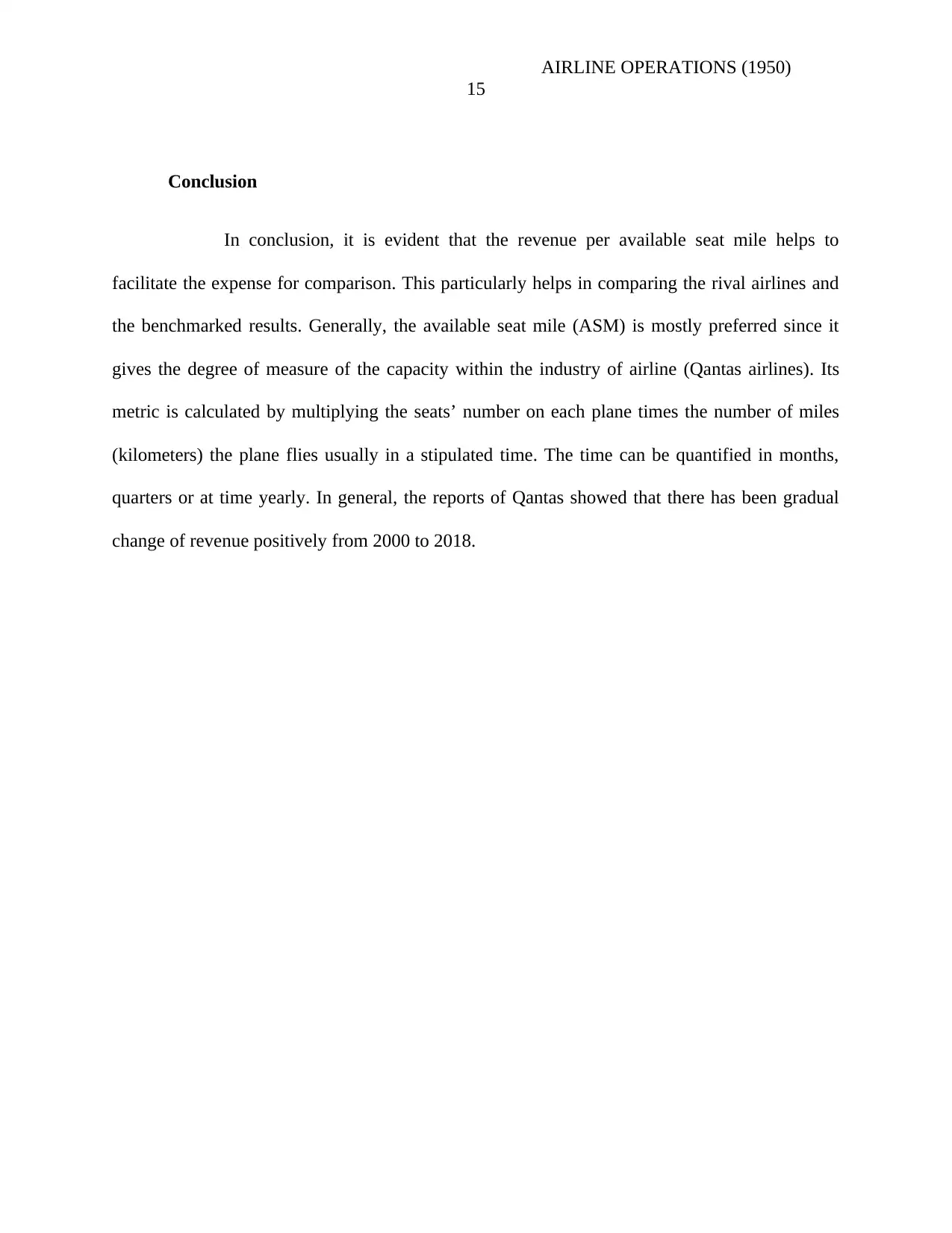
AIRLINE OPERATIONS (1950)
15
Conclusion
In conclusion, it is evident that the revenue per available seat mile helps to
facilitate the expense for comparison. This particularly helps in comparing the rival airlines and
the benchmarked results. Generally, the available seat mile (ASM) is mostly preferred since it
gives the degree of measure of the capacity within the industry of airline (Qantas airlines). Its
metric is calculated by multiplying the seats’ number on each plane times the number of miles
(kilometers) the plane flies usually in a stipulated time. The time can be quantified in months,
quarters or at time yearly. In general, the reports of Qantas showed that there has been gradual
change of revenue positively from 2000 to 2018.
15
Conclusion
In conclusion, it is evident that the revenue per available seat mile helps to
facilitate the expense for comparison. This particularly helps in comparing the rival airlines and
the benchmarked results. Generally, the available seat mile (ASM) is mostly preferred since it
gives the degree of measure of the capacity within the industry of airline (Qantas airlines). Its
metric is calculated by multiplying the seats’ number on each plane times the number of miles
(kilometers) the plane flies usually in a stipulated time. The time can be quantified in months,
quarters or at time yearly. In general, the reports of Qantas showed that there has been gradual
change of revenue positively from 2000 to 2018.
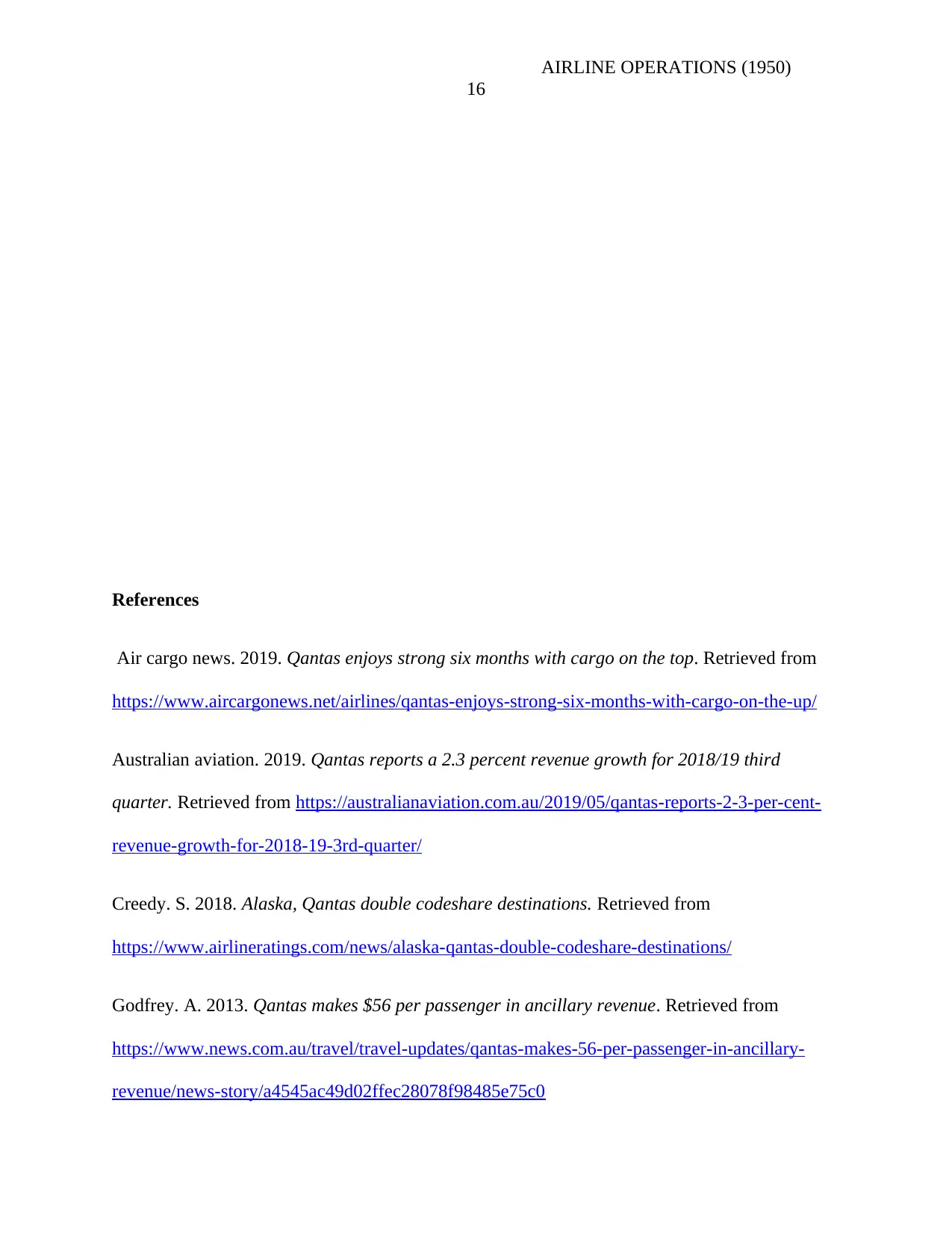
AIRLINE OPERATIONS (1950)
16
References
Air cargo news. 2019. Qantas enjoys strong six months with cargo on the top. Retrieved from
https://www.aircargonews.net/airlines/qantas-enjoys-strong-six-months-with-cargo-on-the-up/
Australian aviation. 2019. Qantas reports a 2.3 percent revenue growth for 2018/19 third
quarter. Retrieved from https://australianaviation.com.au/2019/05/qantas-reports-2-3-per-cent-
revenue-growth-for-2018-19-3rd-quarter/
Creedy. S. 2018. Alaska, Qantas double codeshare destinations. Retrieved from
https://www.airlineratings.com/news/alaska-qantas-double-codeshare-destinations/
Godfrey. A. 2013. Qantas makes $56 per passenger in ancillary revenue. Retrieved from
https://www.news.com.au/travel/travel-updates/qantas-makes-56-per-passenger-in-ancillary-
revenue/news-story/a4545ac49d02ffec28078f98485e75c0
16
References
Air cargo news. 2019. Qantas enjoys strong six months with cargo on the top. Retrieved from
https://www.aircargonews.net/airlines/qantas-enjoys-strong-six-months-with-cargo-on-the-up/
Australian aviation. 2019. Qantas reports a 2.3 percent revenue growth for 2018/19 third
quarter. Retrieved from https://australianaviation.com.au/2019/05/qantas-reports-2-3-per-cent-
revenue-growth-for-2018-19-3rd-quarter/
Creedy. S. 2018. Alaska, Qantas double codeshare destinations. Retrieved from
https://www.airlineratings.com/news/alaska-qantas-double-codeshare-destinations/
Godfrey. A. 2013. Qantas makes $56 per passenger in ancillary revenue. Retrieved from
https://www.news.com.au/travel/travel-updates/qantas-makes-56-per-passenger-in-ancillary-
revenue/news-story/a4545ac49d02ffec28078f98485e75c0
Secure Best Marks with AI Grader
Need help grading? Try our AI Grader for instant feedback on your assignments.
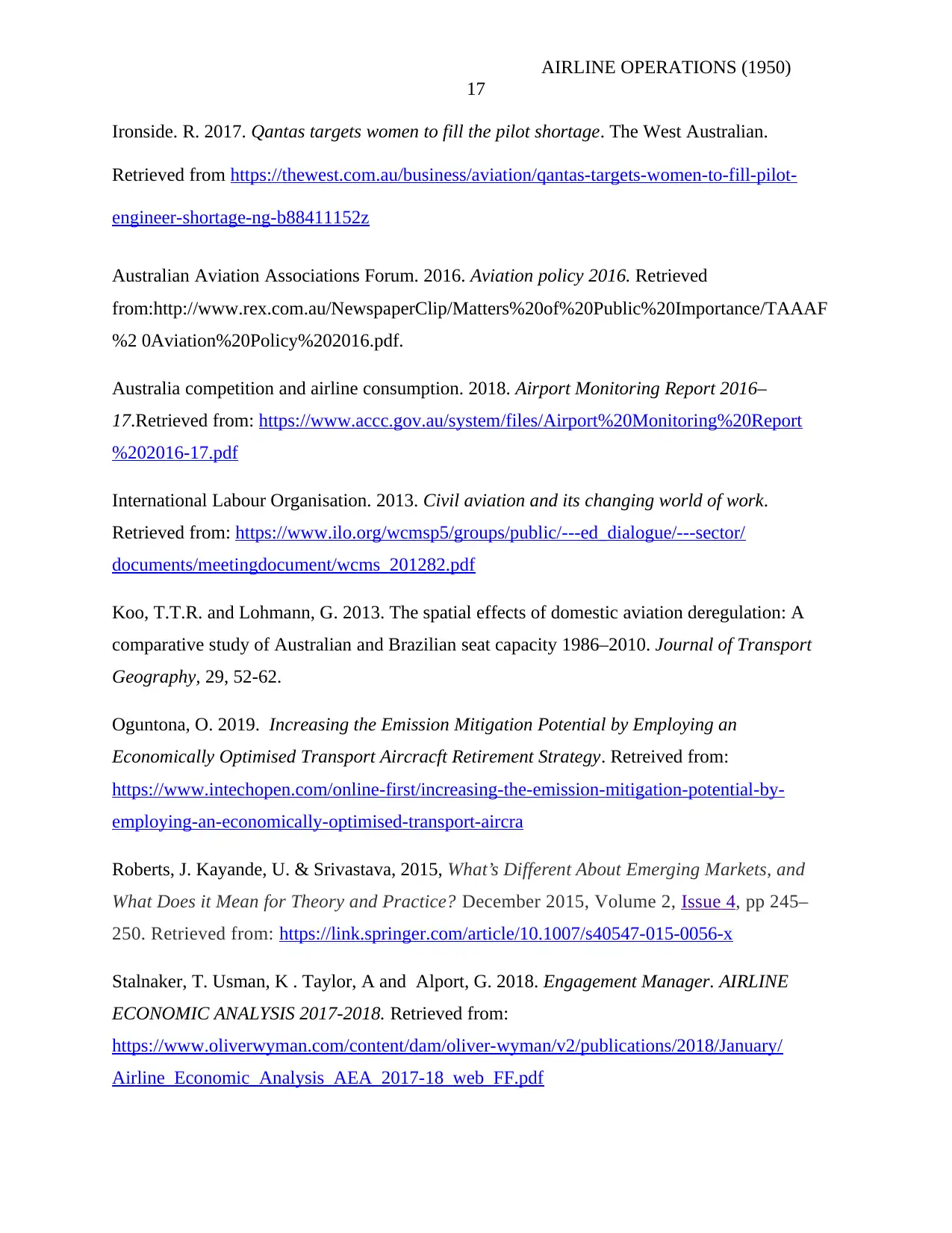
AIRLINE OPERATIONS (1950)
17
Ironside. R. 2017. Qantas targets women to fill the pilot shortage. The West Australian.
Retrieved from https://thewest.com.au/business/aviation/qantas-targets-women-to-fill-pilot-
engineer-shortage-ng-b88411152z
Australian Aviation Associations Forum. 2016. Aviation policy 2016. Retrieved
from:http://www.rex.com.au/NewspaperClip/Matters%20of%20Public%20Importance/TAAAF
%2 0Aviation%20Policy%202016.pdf.
Australia competition and airline consumption. 2018. Airport Monitoring Report 2016–
17.Retrieved from: https://www.accc.gov.au/system/files/Airport%20Monitoring%20Report
%202016-17.pdf
International Labour Organisation. 2013. Civil aviation and its changing world of work.
Retrieved from: https://www.ilo.org/wcmsp5/groups/public/---ed_dialogue/---sector/
documents/meetingdocument/wcms_201282.pdf
Koo, T.T.R. and Lohmann, G. 2013. The spatial effects of domestic aviation deregulation: A
comparative study of Australian and Brazilian seat capacity 1986–2010. Journal of Transport
Geography, 29, 52-62.
Oguntona, O. 2019. Increasing the Emission Mitigation Potential by Employing an
Economically Optimised Transport Aircracft Retirement Strategy. Retreived from:
https://www.intechopen.com/online-first/increasing-the-emission-mitigation-potential-by-
employing-an-economically-optimised-transport-aircra
Roberts, J. Kayande, U. & Srivastava, 2015, What’s Different About Emerging Markets, and
What Does it Mean for Theory and Practice? December 2015, Volume 2, Issue 4, pp 245–
250. Retrieved from: https://link.springer.com/article/10.1007/s40547-015-0056-x
Stalnaker, T. Usman, K . Taylor, A and Alport, G. 2018. Engagement Manager. AIRLINE
ECONOMIC ANALYSIS 2017-2018. Retrieved from:
https://www.oliverwyman.com/content/dam/oliver-wyman/v2/publications/2018/January/
Airline_Economic_Analysis_AEA_2017-18_web_FF.pdf
17
Ironside. R. 2017. Qantas targets women to fill the pilot shortage. The West Australian.
Retrieved from https://thewest.com.au/business/aviation/qantas-targets-women-to-fill-pilot-
engineer-shortage-ng-b88411152z
Australian Aviation Associations Forum. 2016. Aviation policy 2016. Retrieved
from:http://www.rex.com.au/NewspaperClip/Matters%20of%20Public%20Importance/TAAAF
%2 0Aviation%20Policy%202016.pdf.
Australia competition and airline consumption. 2018. Airport Monitoring Report 2016–
17.Retrieved from: https://www.accc.gov.au/system/files/Airport%20Monitoring%20Report
%202016-17.pdf
International Labour Organisation. 2013. Civil aviation and its changing world of work.
Retrieved from: https://www.ilo.org/wcmsp5/groups/public/---ed_dialogue/---sector/
documents/meetingdocument/wcms_201282.pdf
Koo, T.T.R. and Lohmann, G. 2013. The spatial effects of domestic aviation deregulation: A
comparative study of Australian and Brazilian seat capacity 1986–2010. Journal of Transport
Geography, 29, 52-62.
Oguntona, O. 2019. Increasing the Emission Mitigation Potential by Employing an
Economically Optimised Transport Aircracft Retirement Strategy. Retreived from:
https://www.intechopen.com/online-first/increasing-the-emission-mitigation-potential-by-
employing-an-economically-optimised-transport-aircra
Roberts, J. Kayande, U. & Srivastava, 2015, What’s Different About Emerging Markets, and
What Does it Mean for Theory and Practice? December 2015, Volume 2, Issue 4, pp 245–
250. Retrieved from: https://link.springer.com/article/10.1007/s40547-015-0056-x
Stalnaker, T. Usman, K . Taylor, A and Alport, G. 2018. Engagement Manager. AIRLINE
ECONOMIC ANALYSIS 2017-2018. Retrieved from:
https://www.oliverwyman.com/content/dam/oliver-wyman/v2/publications/2018/January/
Airline_Economic_Analysis_AEA_2017-18_web_FF.pdf
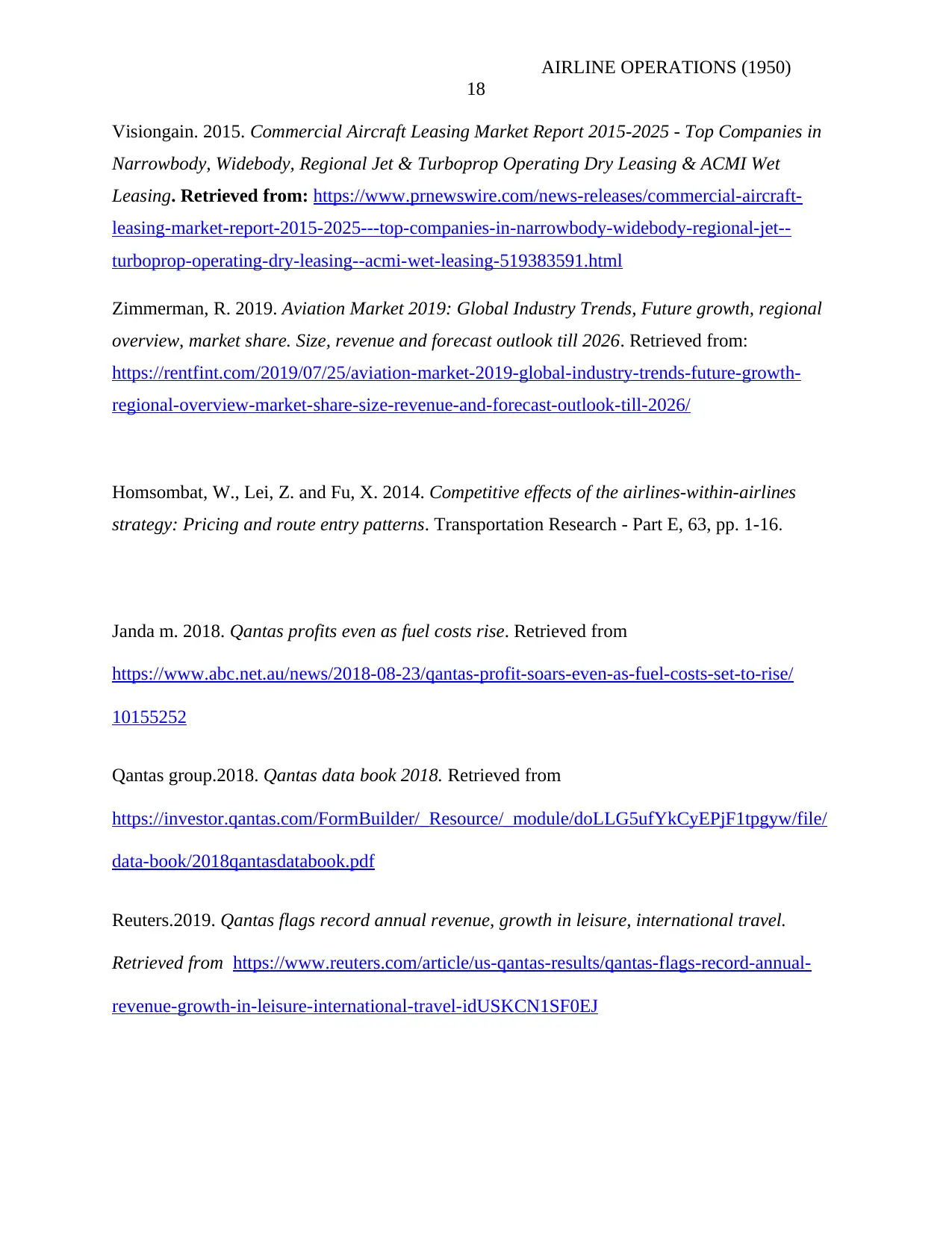
AIRLINE OPERATIONS (1950)
18
Visiongain. 2015. Commercial Aircraft Leasing Market Report 2015-2025 - Top Companies in
Narrowbody, Widebody, Regional Jet & Turboprop Operating Dry Leasing & ACMI Wet
Leasing. Retrieved from: https://www.prnewswire.com/news-releases/commercial-aircraft-
leasing-market-report-2015-2025---top-companies-in-narrowbody-widebody-regional-jet--
turboprop-operating-dry-leasing--acmi-wet-leasing-519383591.html
Zimmerman, R. 2019. Aviation Market 2019: Global Industry Trends, Future growth, regional
overview, market share. Size, revenue and forecast outlook till 2026. Retrieved from:
https://rentfint.com/2019/07/25/aviation-market-2019-global-industry-trends-future-growth-
regional-overview-market-share-size-revenue-and-forecast-outlook-till-2026/
Homsombat, W., Lei, Z. and Fu, X. 2014. Competitive effects of the airlines-within-airlines
strategy: Pricing and route entry patterns. Transportation Research - Part E, 63, pp. 1-16.
Janda m. 2018. Qantas profits even as fuel costs rise. Retrieved from
https://www.abc.net.au/news/2018-08-23/qantas-profit-soars-even-as-fuel-costs-set-to-rise/
10155252
Qantas group.2018. Qantas data book 2018. Retrieved from
https://investor.qantas.com/FormBuilder/_Resource/_module/doLLG5ufYkCyEPjF1tpgyw/file/
data-book/2018qantasdatabook.pdf
Reuters.2019. Qantas flags record annual revenue, growth in leisure, international travel.
Retrieved from https://www.reuters.com/article/us-qantas-results/qantas-flags-record-annual-
revenue-growth-in-leisure-international-travel-idUSKCN1SF0EJ
18
Visiongain. 2015. Commercial Aircraft Leasing Market Report 2015-2025 - Top Companies in
Narrowbody, Widebody, Regional Jet & Turboprop Operating Dry Leasing & ACMI Wet
Leasing. Retrieved from: https://www.prnewswire.com/news-releases/commercial-aircraft-
leasing-market-report-2015-2025---top-companies-in-narrowbody-widebody-regional-jet--
turboprop-operating-dry-leasing--acmi-wet-leasing-519383591.html
Zimmerman, R. 2019. Aviation Market 2019: Global Industry Trends, Future growth, regional
overview, market share. Size, revenue and forecast outlook till 2026. Retrieved from:
https://rentfint.com/2019/07/25/aviation-market-2019-global-industry-trends-future-growth-
regional-overview-market-share-size-revenue-and-forecast-outlook-till-2026/
Homsombat, W., Lei, Z. and Fu, X. 2014. Competitive effects of the airlines-within-airlines
strategy: Pricing and route entry patterns. Transportation Research - Part E, 63, pp. 1-16.
Janda m. 2018. Qantas profits even as fuel costs rise. Retrieved from
https://www.abc.net.au/news/2018-08-23/qantas-profit-soars-even-as-fuel-costs-set-to-rise/
10155252
Qantas group.2018. Qantas data book 2018. Retrieved from
https://investor.qantas.com/FormBuilder/_Resource/_module/doLLG5ufYkCyEPjF1tpgyw/file/
data-book/2018qantasdatabook.pdf
Reuters.2019. Qantas flags record annual revenue, growth in leisure, international travel.
Retrieved from https://www.reuters.com/article/us-qantas-results/qantas-flags-record-annual-
revenue-growth-in-leisure-international-travel-idUSKCN1SF0EJ
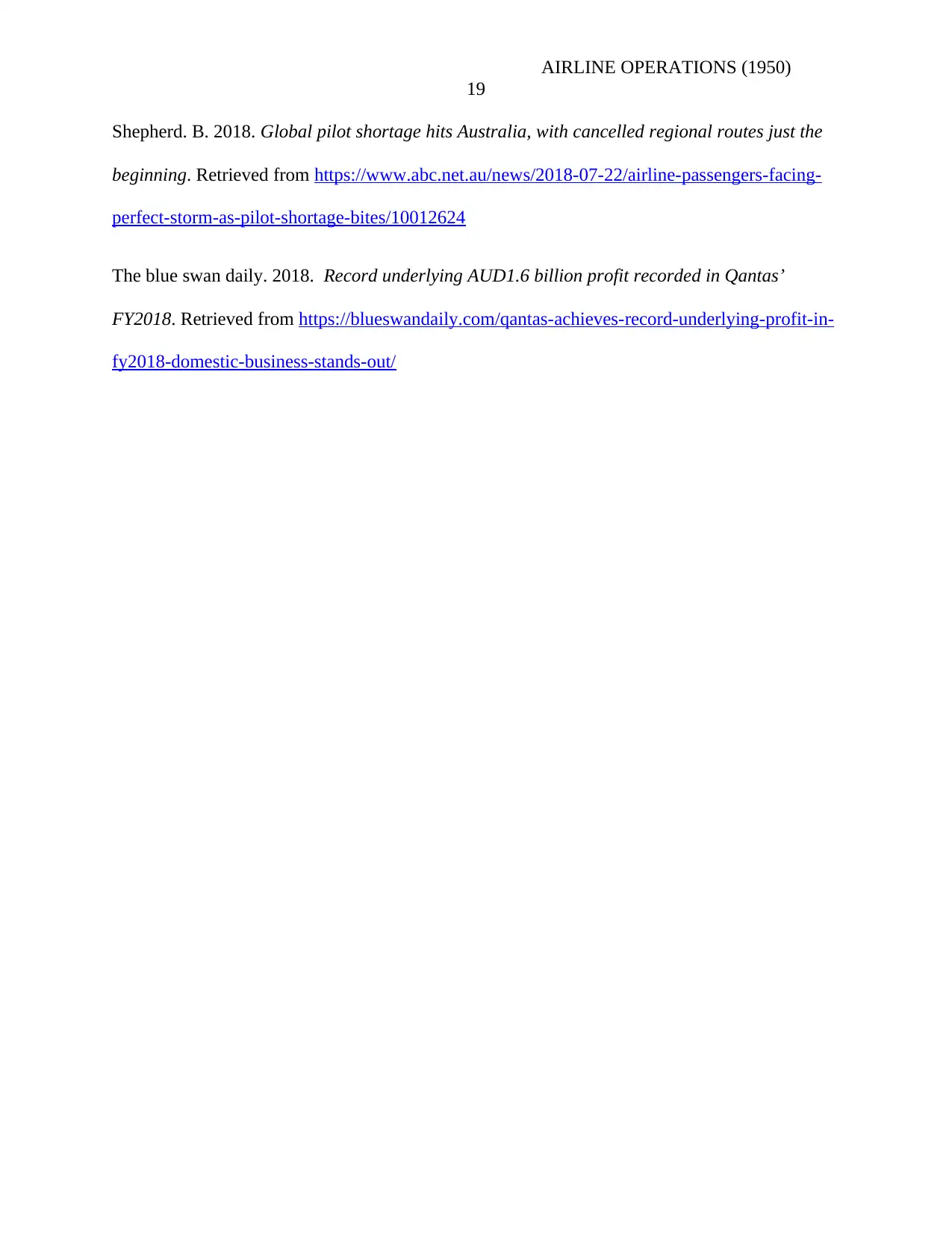
AIRLINE OPERATIONS (1950)
19
Shepherd. B. 2018. Global pilot shortage hits Australia, with cancelled regional routes just the
beginning. Retrieved from https://www.abc.net.au/news/2018-07-22/airline-passengers-facing-
perfect-storm-as-pilot-shortage-bites/10012624
The blue swan daily. 2018. Record underlying AUD1.6 billion profit recorded in Qantas’
FY2018. Retrieved from https://blueswandaily.com/qantas-achieves-record-underlying-profit-in-
fy2018-domestic-business-stands-out/
19
Shepherd. B. 2018. Global pilot shortage hits Australia, with cancelled regional routes just the
beginning. Retrieved from https://www.abc.net.au/news/2018-07-22/airline-passengers-facing-
perfect-storm-as-pilot-shortage-bites/10012624
The blue swan daily. 2018. Record underlying AUD1.6 billion profit recorded in Qantas’
FY2018. Retrieved from https://blueswandaily.com/qantas-achieves-record-underlying-profit-in-
fy2018-domestic-business-stands-out/
1 out of 19
Related Documents
Your All-in-One AI-Powered Toolkit for Academic Success.
+13062052269
info@desklib.com
Available 24*7 on WhatsApp / Email
![[object Object]](/_next/static/media/star-bottom.7253800d.svg)
Unlock your academic potential
© 2024 | Zucol Services PVT LTD | All rights reserved.




